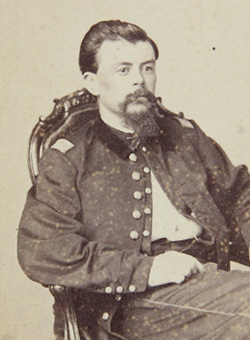
Please send all Checks and Money orders to :
Dave Taylor P.O. Box 87 Sylvania, OH 43560
419-842-1863
Click Here to E-mail Us!


15 11
LAYAWAYS ARE WELCOME:
Need to split your order into multiple payments? No problem! A simple 20% earnest money deposit will hold your item for you.
You can then pay it off in easy installments that fit your budget.
Read Terms Here
~~~~~~~~~~

15-11-00 … Stunning Militia Cavalry Carbine Ca. 1740 / Colonial American? …
Without question the rarest cavalry weapon I have ever handled and one of the earliest guns I’ve offered for sale. This is an “English lock” (aka Dog Lock) carbine for militia cavalry circa 1740, using a high quality barrel and lock dating from 1650-70. It is a weapon that was manufactured during the era of the English Civil War, and remained in service through the 18th century when it was restocked and retrofitted with sling ring and state of the art hardware… remaining in military service as a first quality arm. It could very well have seen service in Colonial America, The French & Indian War, and the Revolutionary War. Scholar Dewitt Bailey describes a whole class of “utility” arms rebuilt in Colonial America from outmoded locks and barrels purchased by individuals, units, and colonial assemblies for militia use. The parts were purchased from sources in England. This gun is much better made than a common infantry musket. It exhibits as much refinement as a great Kentucky rifle. This is not unexpected for militia cavalry, as members thereof were generally from wealthy families living in wealthy communities. These gentry soldiers were well enough off to provide not just their own horses, but purchase their own uniforms, weapons and equipment. In America these troops tended to come from cities like New York, Albany and Charleston, but in the 1660s Virginia fielded a “troop of horse” (translates as Company of Cavalry) in each of its 19 counties. Similar details are known of cavalry in Massachusetts, Maryland and New York from the same period, right up to the Revolution. In 1773 New York’s Governor reported the colony had 11 “troops of horse”, along with 26 regiments of foot. Arms required usually consisted of a sword, pair of pistols and often a carbine described as “fixed with a belt and swivel,” indicating a short cavalry carbine fitted with sling bar and ring like this one, to be carried by a carbine sling over one shoulder.
This carbine measures 42 inches overall, from the muzzle to the toe of the butt plate. Octagonal smooth bore barrel .75 caliber, 26 5/8 inches long. Muzzle has a narrow ring defining it and a small round front sigh showing it has always been this length and is not cut down. Long iron side bar and ring for a sling swivel on the left side. Brass mounts with upper and lower ramrod thimbles, flat side plate, trigger guard with flat tangs. Some parallels with Board of Ordnance arms suggest the dating for the stocking: the forward trigger guard tang shows in outline the classic pineapple/urn shape that becomes quite simplified on Ordnance muskets in the 1730/40 patterns, and a recurved rear branch of the trigger guard that appears on 1742 Ordnance pattern muskets, but was first introduced in sea service pistols in 1716. Along with the well-defined “handrail” these characteristics date the restocking to about 1740, roughly the period of “King George’s Wars,” just before the Seven Years War, known as the French and Indian War over here.
The lock dates to the period of the English Civil War, about 1650, and not later than ca. 1670, utilizing the “English lock,” characterized by continued use of a laterally acting sear inside the lock and continued use of a “dog” or “ketch” to secure the hammer at half-cock. The square backs and pinched fronts of the jaws point to an early date, as does the use of a hammer with integral post that is pinned to the tumbler inside the lock rather than using an external hammer screw. Simply googling “English lock,” “dog lock” or “ketch lock” will turn up some good reference sources.
The lock is clearly marked “WL” upside down, and the barrel has a similar mark, though it seems to be from a different die strike with the “L” partly obliterated. I don’t find any reference parallels and WL’s identity is unknown as yet. There is a small bit of wood damage on the left butt flat that looks like it was filled at one point and two small rectangular inserts in the wood on either side of the muzzle. A mortise in the upper barrel flat near the breech shows a rear sight was once mounted. Upper butt plate screw is missing, but the wood and metal of the butt are solid and tightly fitted. A few minor scratches and one or two hairlines in the wood, but nothing keeping it from rating excellent. Same is true of the metal, which is smooth overall with a deep plum color. Mellow tone to the brass. Missing the ramrod, which was likely wood with a brass tip and easily replaced with a copy. In an era where collectors pay the price of luxury real estate for factory produced Colts and Winchesters, here is a most historical weapon with incredible eye appeal and condition, that also “lived” through the 1600s, 1700s, 1800s, 1900s, and 2000s. A damn fine EARLY piece at a realistic price. A real Colonial era flintlock
… $13,500.00
Click Here to E-mail Us!
Call us @ 419-842-1863
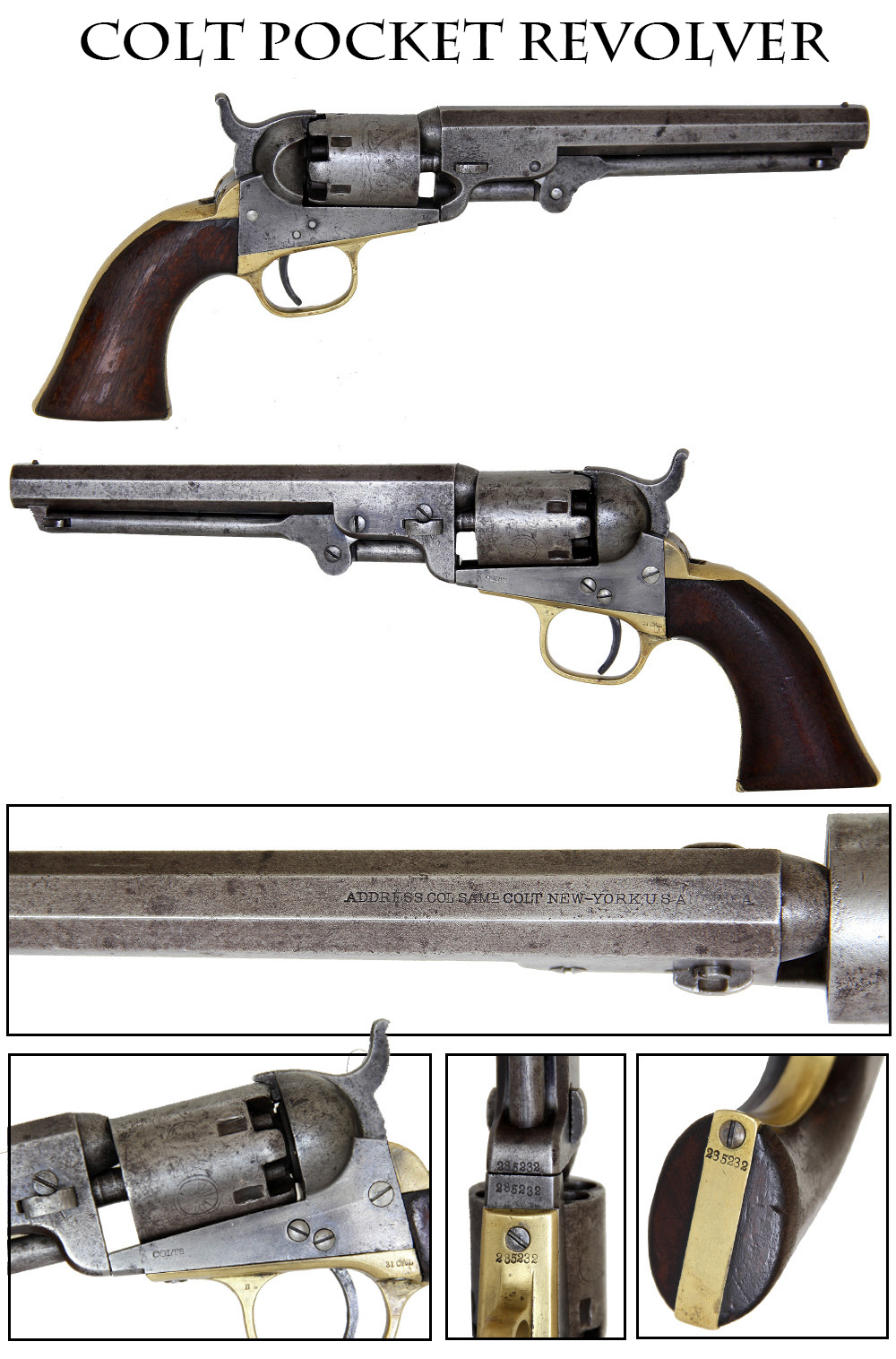
15-11-01 …
Six Inch Colt Pocket Revolver …
Nice example of one of Colt’s best looking guns, the 1849 Pocket Revolver. Excellent grips, tight wood to metal fit. The barrel legend is a one line New York address. “Colts Patent” on the frame visible and a bit light on the word “patent”. Matching serial numbers 285232 throughout … the rammer is not numbered – which is proper in this serial range … Barrel, loading assembly and frame show a matching even smoky grey patina. The cylinder shows vestiges of the stagecoach holdup scene. The “Colts Patent” marking and serial number are still very clear on the cylinder. Screw slots are good, mechanics good. Metal smooth overall. These .31 caliber pistols were favorites of officers who needed a side arm but did not want to lug around a belt size revolver. They first became popular in the gold fields of California and continued into the early days of the Wild West. The proportions of the gun make it very pleasing, and there are enough variations in its manufacture that a couple of books have been written about it and it is a collecting field of its own. It came in several barrel lengths. The six-inch is the best proportioned … eej-allis
… $950.00 – SOLD
Click Here to E-mail Us!
Call us @ 419-842-1863
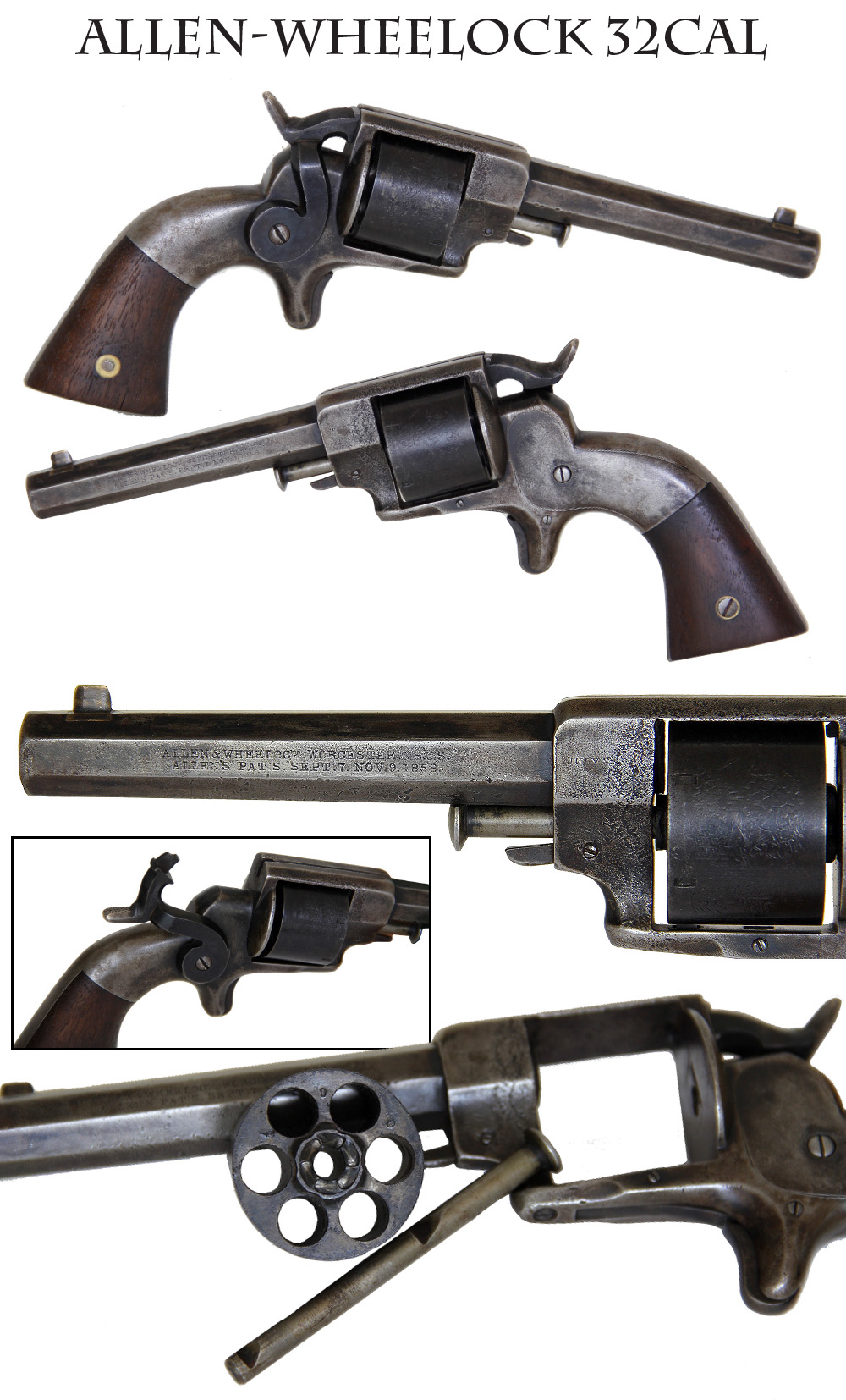
15-11-02 … Allen & Wheelock 32 Caliber Sidehammer Revolver …
This gun has a 4 inch long octagonal barrel stamped on the side “ALLEN & WHEELOCK WORCESTER. MS.US. / ALLEN’S PAT’S/ SEPT. 7, NOV. 9, 1858” and the frame is marked “JULY 3, 1860”. The gun is in VG + condition and is mechanically perfect. The cylinder is the 7/8ths variation and has a vivid rolled cylinder scene. The walnut grips are VG. A nice early rimfire revolver
… $595.00 – SOLD
Click Here to E-mail Us!
Call us @ 419-842-1863
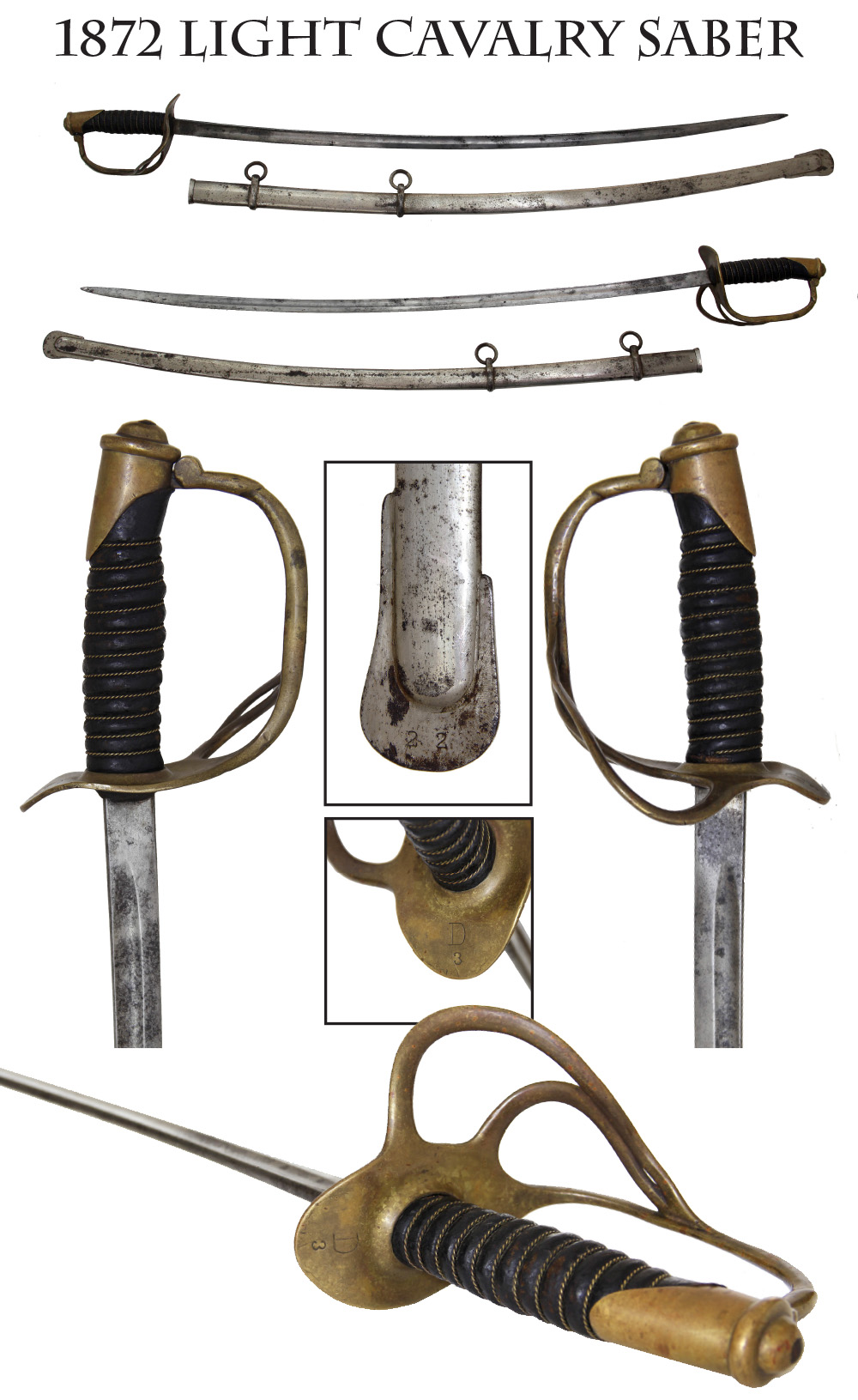
15-11-03 … 1872 Light Cavalry Saber …
Cavalry officers were ordered to adopt a lighter version of the 1860 style saber in 1872… hence the new model. Enlisted versions hit the market soon after, generally used by militia troopers. This one shows the typical narrow blade with long ricasso and unstopped fuller. The hilt with three-branch guard and wire wrapped leather grip remained like the 1860 pattern, but a bit lighter. The leather and color color of brass are good. There is slight bend to the outer branch of the guard, but nothing unexpected in an issued piece. Ours has a company letter “D” over a “3” on the inner face of the guard, the number being either a trooper’s rack number or regimental designation. The blade has a good edge and point. Light silver mixed with gray clouds and spots overall, scattered lower down, heavier near the hilt. The scabbard is complete with throat, drag and rings, in the bright with darker areas, mostly in the left side, which would rub against the horse’s flank. The number “22” is stamped on the drag, indicated the saber and scabbard were switched or the number on the drag is the rack number and “D/3” is the unit designation. A good example and necessary part of an American edged weapons collection … ej-mil
… $295.00 – SOLD
Click Here to E-mail Us!
Call us @ 419-842-1863

15-11-04 … Pre-War Infantry NCO Sword …
The army followed a long tradition in issuing swords to infantry sergeants as badges of rank: they ran the company on a day to day basis and in the line of battle acted as file closers, supervising the men in action. In 1840 a new pattern replaced the old 1833 short sword, this one with a more elegant long straight blade with single fuller and short false edge. It also has a brass hilt with a ribbed grip imitating wire wrapping, a D-guard knucklebow, and a double clamshell guard.
This is a RARE pre-war example with an Ames Mfg. Co./Chicopee/Mass stamp on one side of the ricasso and US/JH/1855 on the other. Blade has good point and edge, silver gray with bright areas showing through. Leather washer in place under the guard. Ames issued these with brass mounted leather scabbards, which as every collector knows are subject to breaking. An astute NCO substituted a brass mounted metal scabbard at some point with this one, likely liberated from an Emerson and Silver wartime product. Guard and scabbard have matching patina on the brass. A couple of minor handling dings to the hilt. Correct RHKW inspector stamp on the knuckle guard. A very good example of sword of the pre-war regular army that was posted in the west, seeing service against Indian tribes, an expedition against the Mormons, and vain attempts to keep peace in Kansas. Try and find one cheaper … bej-mil
… $395.00 – SOLD
Click Here to E-mail Us!
Call us @ 419-842-1863
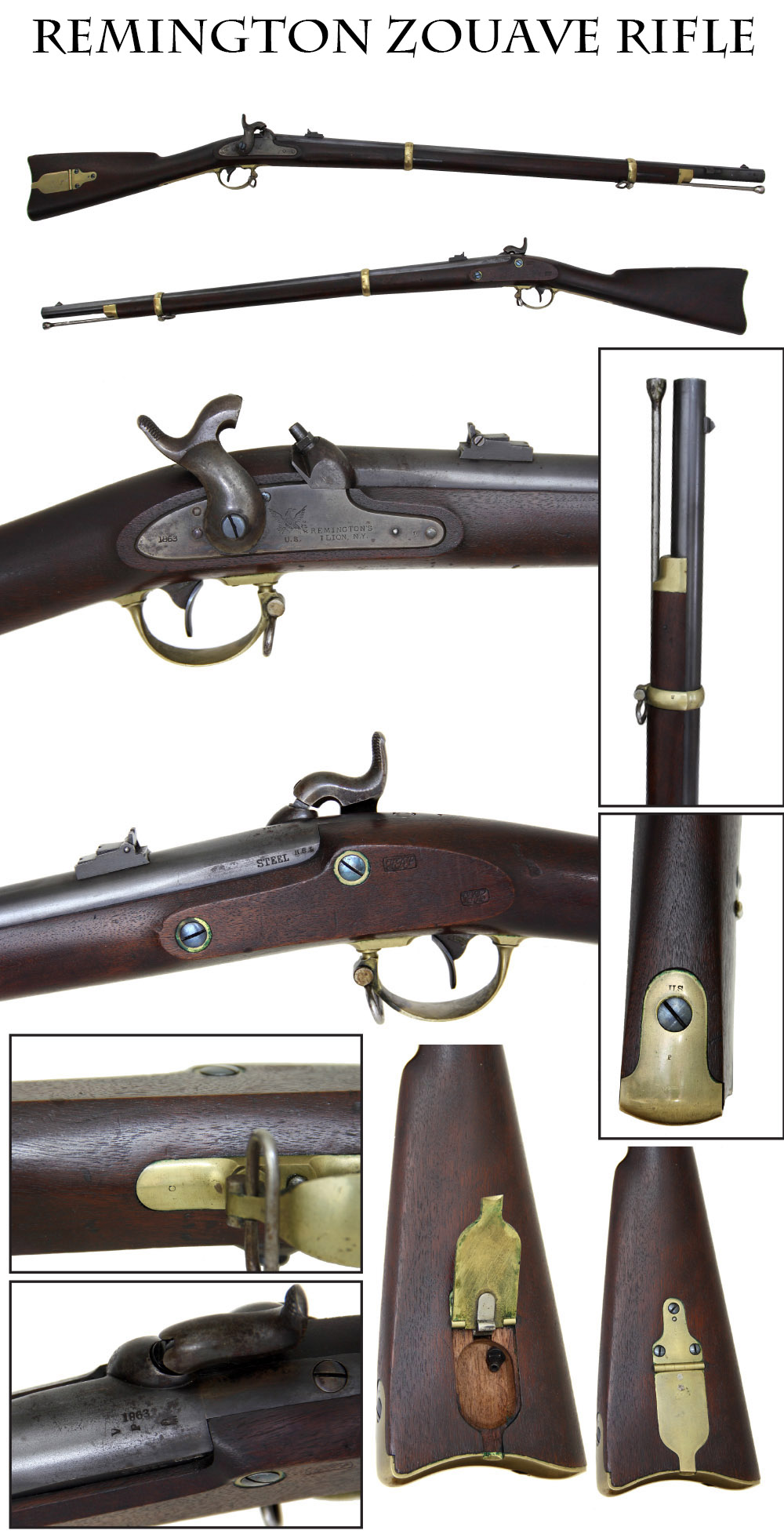
15-11-05 …
Minty Remington Zouave Rifle …
A very fine, high finish example of the Remington Zouave Rifle. The actual name for these rifles is the Remington 1863 Percussion Contract Rifle, but decades of collectors calling them “Zouave Rifles” is hard to overcome. One of the most attractive rifles ever produced for the US Army, their use is still something of a mystery. It is known that Remington produced 12,501 and most are dated 1863. Designed with brass mounts, including a patch box, these were clearly designed on the old rifle patterns descended from the Model 1841 Mississippi and 1855 Harpers Ferry rifles. This one is in NRA excellent condition. Extra Extra Fine. Sharp Remington lock markings and barrel proofs with matching 1863 dates, beautiful muted barrel blue, about 100% with just some gray speckling near the bolster. Near mint bore with seven groove rifling. Sharp wood with crisp cartouches on the offside, crisp “Steel” barrel stamp and barrel inspector initials on the left. The screw heads also show blue. Swivels, springs, bands, rod and sights in place. Stud in place at muzzle for the brass handled saber bayonet. Blue on the hammer screw and some light case on the lockplate, also has the extra nipple inside the patch box. I wager you won’t find one as nice as this, priced this low, at any shows you attend this year … cjjj-150502
… $3,250.00
– SOLD
Click Here to E-mail Us!
Call us @ 419-842-1863
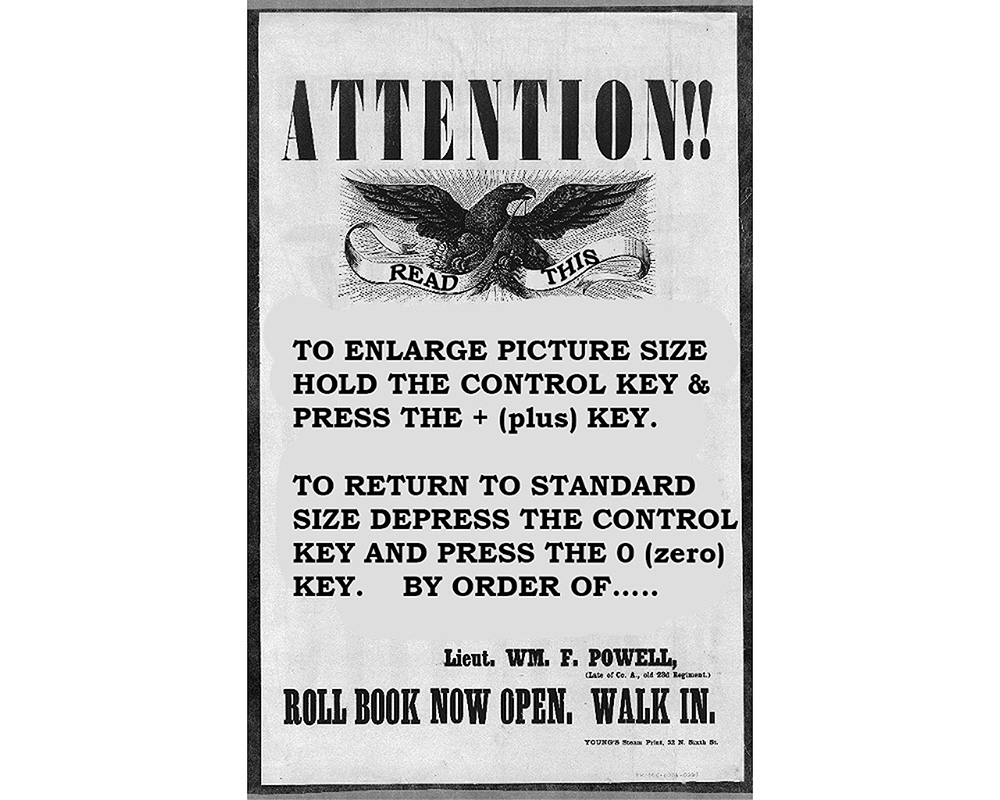
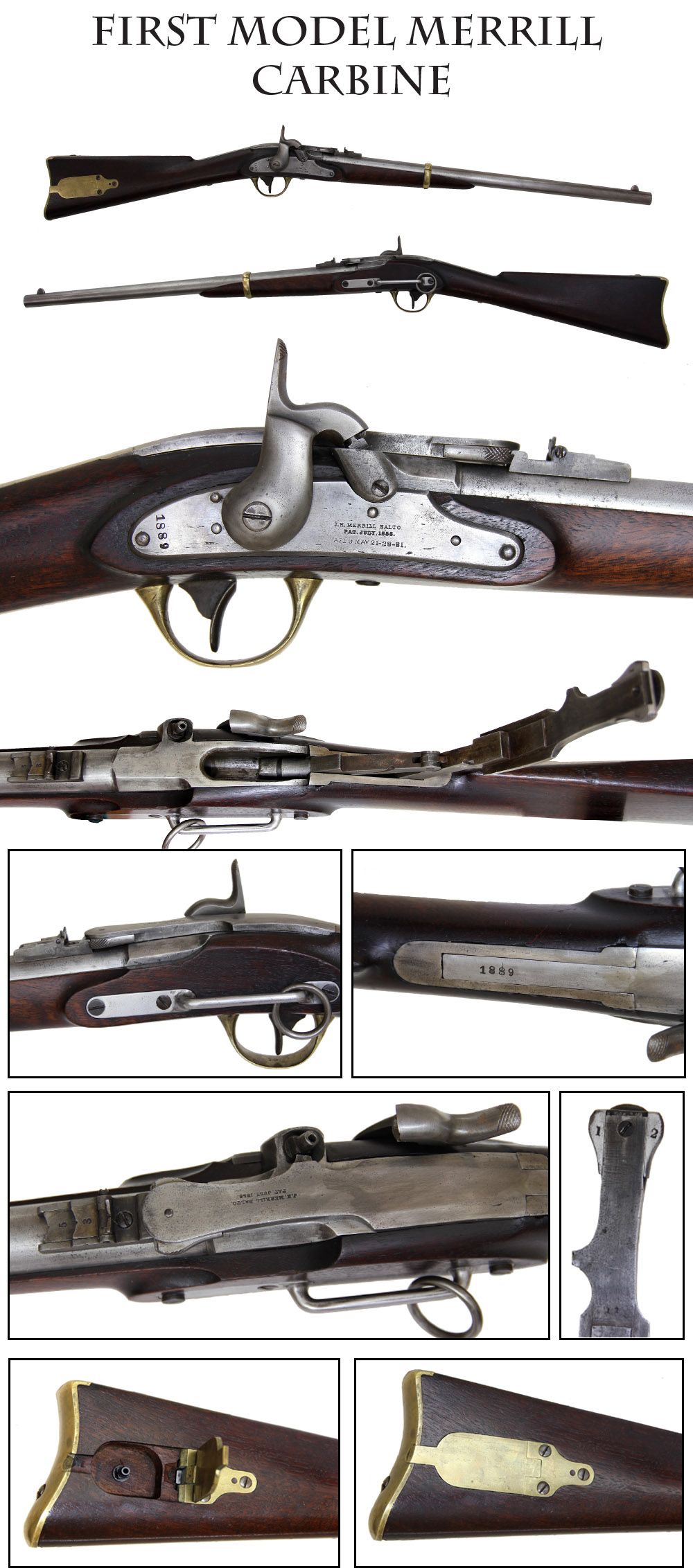
15-11-06 … EXTREMELY Fine, Extra Crisp First Model Merrill Carbine …
Near mint wood on this First Model Merrill is the only way I can describe it… razor sharp edges. You can see how sharp the edges are from across the room. Not cartouched, so either a state issue gun, or privately purchased from a military outfitter. One of the best pieces of wood I’ve seen on a Merrill. Merrill’s are among the best looking Federal carbines because of their brass patch box, butt plate, trigger guard and barrel band. Brass furniture is always a plus. Single-shot .54 caliber breechloader opening from the top with a lever. This first pattern has the characteristic patch box and correct flat ears on the lever release catch. Matching serial #1889 on the lock and loading mechanism. Clear Merrill maker and patent marks on the plate and loading lever. Barrel, receiver, loading mechanism, hammer and lock plate are excellent “in the white”. Some Merrills were finished lacquer brown. Some were blued. And some were finished “in the white”… no chemical finish used whatsoever. Ours certainly appears to be one of the latter. All steel is smooth, and free from rust or pitting. Some scattered small gray spots and faint traces of case color on the lockplate between the hammer and bolster and on the loading assembly, stronger on the underside. Brass has an even, medium tone. Front and rear sight with leaves, barrel band, patch box, side bar and sling ring in place. Even the spare nipple is still screwed into the wood inside the patchbox. 100% original and complete with no repairs and no replaced parts. A top shelf Merrill in all respects. Always highly sought, these carbines saw heavy service before the war and in the hands of both Union and Confederate troopers. Many a Maryland and Virginia reb’ carried a Merrill on his saddle. The government ordered significant quantities and there are a number of variations. The 1st and 5th NY Cav., the 11th and 17th PA Cavalry, and other units carried them. I even owned one carried by a Virginia Trooper in Ashby’s Cavalry some years ago. Total production of all types was around 15,000. You will be hard pressed to find one to rival this … noco
… $3,750.00 – SOLD
Click Here to E-mail Us!
Call us @ 419-842-1863
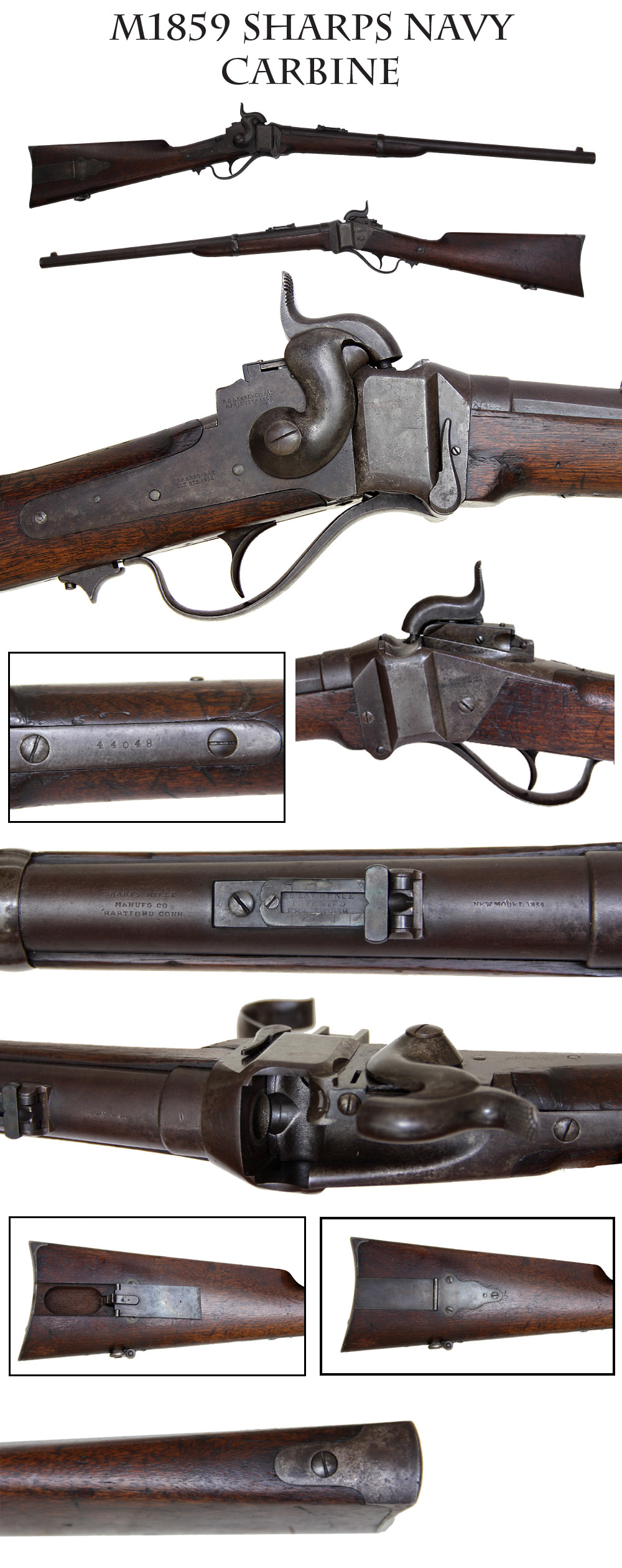
15-11-07 … Rarest of the Rare – M1859 Sharps Navy Carbine …
One of the rarest of all Sharps shoulder weapons. Very, very scarce New Model 1859 Sharps Naval Carbine. Made like the army carbines with a .52 caliber 22-inch round barrel, these guns have the standard Sharps markings on the barrel, frame and lockplate. They were manufactured without the sidebar and sling ring, having a rifle style sling swivel in the buttstock instead. These guns are so rare even experienced collectors sometimes do not recognize them. In 40+ years I guess I’ve seen three or four. The US Navy had experimented with Sharps carbines since 1850 and ordered small quantities of the m1851 and m1855 patterns, but shifted its focus to the rifles equipped with a saber bayonet just before the war. In 1861 competition for the rifles was fierce and the Navy resorted to procurement through the Union Defense Committee in New York and a contract with John T. Mitchell, a Sharps agent. Somewhere in the mix the navy also acquired a small number of these m1859, void of sling ring type, carbines in the 40,000 – 44000 serial number range. One recent bit of research indicates the group numbered 300 guns and were obtained from gun dealer J.C. Grubb of Philadelphia, and few of this group survived conversion: 190 were turned in by ships in the Mississippi Squadron in 1865 and were sent out for cartridge conversion in 1868. This would mean only 110 unconverted carbines were left for collectors. Ours has very good wood with a tight fit to the metal and good edges. Just minor handling marks and dings here and there. Boxed “C.W.H.” cartouche (as shows up on one other example) is marred but visible on left wrist. Smooth blue faded to plum brown patina to the barrel and very nice age-faded mottled case color on the receiver, and nice color on the iron patch box and rear sight as well. Scattered light pitting to the upper surface of the breechblock from the effect of the percussion caps, just enough to show this gun was well cared for, but also used. Front and rear sights in place, with ladder and elevation bar. Crisp Sharps and Lawrence patent markings on the receiver. Sharp barrel markings, the New Model 1859 stamp just a tad light along the bottom edge. Tight fitted butt plate, gray mixed with some faded mottled colors. Serial number 44048, placing it dead-on in the correct serial number range for these guns. Ours even retains the original correct swivel in the buttstock. On some examples this is replaced by a larger ring, apparently done after the war to fit them for a carbine sling when some got into the hands of the army, who were not sure where they had come from or how best to alter them for mounted use … noco
… $4,500.00 – SOLD
Click Here to E-mail Us!
Call us @ 419-842-1863

15-11-08 … Near Mint Rifled and Sighted / 1853 Dated Springfield Model 1842 …
Excellent seems too low a grading for this gun. It isn’t mint, but it’s close… so NRA “Excellent” it is. Crisp, sharp wood, with a sharp inspector’s cartouche on the offside. Wood tightly fitted to the metal, which is smooth and in the bright with vivid markings. Sharp eagle over US forward of the hammer and Spring/field/1853 aft. Excellent mechanically. Literally no firing corrosion around the nipple and bolster. Crisp V/P/eagle barrel proofs and a vivid 1852 barrel date that shows with the lock date that the gun was assembled early in 1853. This is also one of the 1842s that was updated to compete with the 1855 patterns by being rifled and sighted: the early pattern long-range rear sight is present and complete. All bands, swivels, springs and the rod are in place. This is one heck of a ’42.
There are a few tiny scattered gray spots (or dust as a friend terms it) to the metal and couple tiny abrasion spots or dings to the wood, but none of it is very noticeable. Darn close to the way it looked when it came out of the crate, heck, close to how it looked when it went into the crate at the armory. I would be proud to have it in my own collection. You will be, too
… $3,750.00
Click Here to E-mail Us!
Call us @ 419-842-1863

15-11-09 … Captain Butler Ward’s Chess Set and Letters – 74th Illinois, Injured at Stone River …
The 74th Illinois recruited in the fall of 1862 at Camp Fuller in Rockford, Ill., and served in the Army of the Ohio and Army of the Cumberland. Ward resided in Rockford, officially enlisted on 9/4/62 and was commissioned Captain of Co. K to date the same day. During Ward’s service the regiment saw its first action in December in a skirmish at Nolensville, followed by some of its heaviest fighting at Stones River, where it lost 8 killed, 35 wounded and 42 missing or captured in two days of hard fighting. 15 letters in total … mostly civilian wartime letters from wife, a few pre war, most wartime civilian letters to Capt Butler or his family… and a couple soldier letters . One soldier letter from August Todd to Butler’s wife relates … “… Your poor husband was seriously injured, in the back and side by the falling of a tree which was struck by a cannon ball. Marcus Parmalee is no more. He was killed by the concussion of a shell and a young man by the name of Tilmley in Co K was killed …” Then we have a letter from the tree injured Butler Ward himself to his wife. He writes from the hospital “I suppose you have received a letter from Lieut Lakin informing you that on the 31st of DEC during the battle I got hurt by the falling of a tree. Well it was quite a blow, for I did not know myself for 24 hours … Henry Heagle is in the room, he got a ball in the leg below the knee and the other day the doctor cut out the ball … he is very nervous and much afraid …” His wife details the gathering people in the community to share news of the battle, the grief of Mrs. Parmalee, and efforts to send boxes and supplies to the men of the company. Butler Ward resigned his commission in March, 1863, and chances are it was related to his Stones River injuries.
Ward’s chess set is missing a few pieces, but substantially there and housed in a reddish/orange painted box with his name scratched in the cover, along with seven small dice. Together with the letters they are a nice display of wartime items representing camp life, but with the extra association of belonging to an officer who was in one of the fiercest battles of the war. He may have had the chess set with him in the hospital. Neat grouping that displays great
… $450.00 – SOLD
Click Here to E-mail Us!
Call us @ 419-842-1863

15-11-10 … ID’d Chasseur Cap and Straps of Captain David H. Dyer – 7th Mass. …
David Hartwell Dyer was a 27 year-old bookkeeper in Fall River, Mass., who raised a squad of volunteers immediately on hearing of Fort Sumter. The group became the nucleus of Company A of the 7th Mass. Volunteers and Dyer was commissioned its Captain on 6/15/61. He drilled and trained the company and led it to Washington. Dyer left the unit late in the year and returned to Massachusetts, where he set to organizing the 3rd Massachusetts and both the 5th and 21st Unattached Companies of Massachusetts Infantry, serving about three months in each of the latter two as an officer. After the war he was a successful businessman in constructing cotton mills and an active member of the GAR. His family preserved his officer’s chasseur style cap. It has a nice flat, bound visor with eagle-I chinstrap buttons, dark blue body with bullion cording around the base and in a quatrefoil on the top. Low on the front is stitched an officer’s bullion infantry hunting horn, showing some fading to the backing and greenish tint to the edges of the bullion, but generally good. The sweatband is in place but lining is long gone. A piece of old newspaper is stuck to the underside of the crown. The family attached a small piece of tape with the name “Capt. Dyer” to identify it. Accompanying the cap are Dyer’s captain’s straps: light blue background, borders and bars oxidized to gray, but the jacqueron wire edging is present. The edges were never turned under and it is likely a pair he never mounted on a coat. One small pulled section to one strap edge, otherwise very good. With these two pieces the family preserved woman’s daguerreotype portrait housed in a Peck’s Union Case, and a somewhat later copy print, torn on one corner of the mount, with notations on the back. Her relationship to Dyer is unknown to me, but could probably be determined with some research. Lastly is a modern copy print of a wartime image of Dyer in uniform. The original was retained by some branch of the family, but it is a nice shot of him in his officer’s frock coat with sash, waist belt and sword, holding his cap under his arm and a pair of gloves in his hand. During Dyer’s time with the 7th Mass., it was stationed on Kalorama Heights in Georgetown, under Col. Darius Couch, who later became a brigadier and eventually a corps commander. A nice honest grouping, not puffed up and expanded by throwing in odds and ends from the local antique mall. The cap alone is worth the price of admission
… $3,950.00 – SOLD
Click Here to E-mail Us!
Call us @ 419-842-1863

15-11-11 … Tintype, Belt Plate and letters of Danial O. Clough, 23rd New York …
I obtained this lot directly from the family in two installments. Nicknamed the Southern Tier Rifles, the 23rd was one of New York’s two-year regiments, raised and rushed into service by the state before the US government set the enlistments at three years. Daniel O. Clough was 32 years-old when he enlisted at Cortland, NY, on 5/8/61 and mustered in on 5/16/61 as a private in Co. H. He made it to corporal before being busted back to private, but thought enough of his rank to keep his NCO belt plate as a souvenir. He was mustered out in Elmira on 5/22/63. The regiment served with the Army of the Potomac and Pope’s Army of Virginia. They saw action at Fair Oaks, Second Bull Run, South Mountain, Antietam and Fredericksburg, losing 17 enlisted men killed or mortally wounded in battle. The set consists of 15 letters, his early war eagle buckle with 3-piece silver wreath, and a nice sixth plate tintype in uniform. The letters include some excellent letters to his family, and a couple from family members … in one, a family member writes to a niece Anna, writes of President Lincoln’s assassination: “… The last two days have been very sad here. Saturday morning in the dispatch came of the awful tragedy at Washington and all business was suspended and men and women were suffering as though they had lost their own family. the President is to be brought to Illinois for burial. It followed so soon on a great day of enjoying last Monday. The flags were flying on buildings and ?? and cannons firing all over the county and Saturday black flags were flying and passenger trains were draped in black their whole length and doors with crape on them. Illinois and New York have lost their best son and God only knows what will the consequences of it …” In another, our soldier writes to his mother: “… I with two others have been scouting around this morning and have sloped to a large white house. It belonged to a secessionist and they have all run. They left it in charge of an old negro. We have took possession of the parlor and center table and three large arm chairs and am enjoying myself very much in writing to you …” August 1st 1861 he writes … “… last Sunday we woke up with the cry Fall-In Fall-In. The whole regiment was in line of battle in less than seven minutes. The cause of the alarm was ten of the rebels picket attacked our picket guard. Our men killed seven of them and took three prisoner. … There is probably 40,000 soldiers in sight of us and we are going to whip the devil out of them rebels next time… ” Other letter content includes marching, trips to the hospital, newsy observations, etc. … A great lot of items offered publicly here for the first time.
… $950.00
Click Here to E-mail Us!
Call us @ 419-842-1863
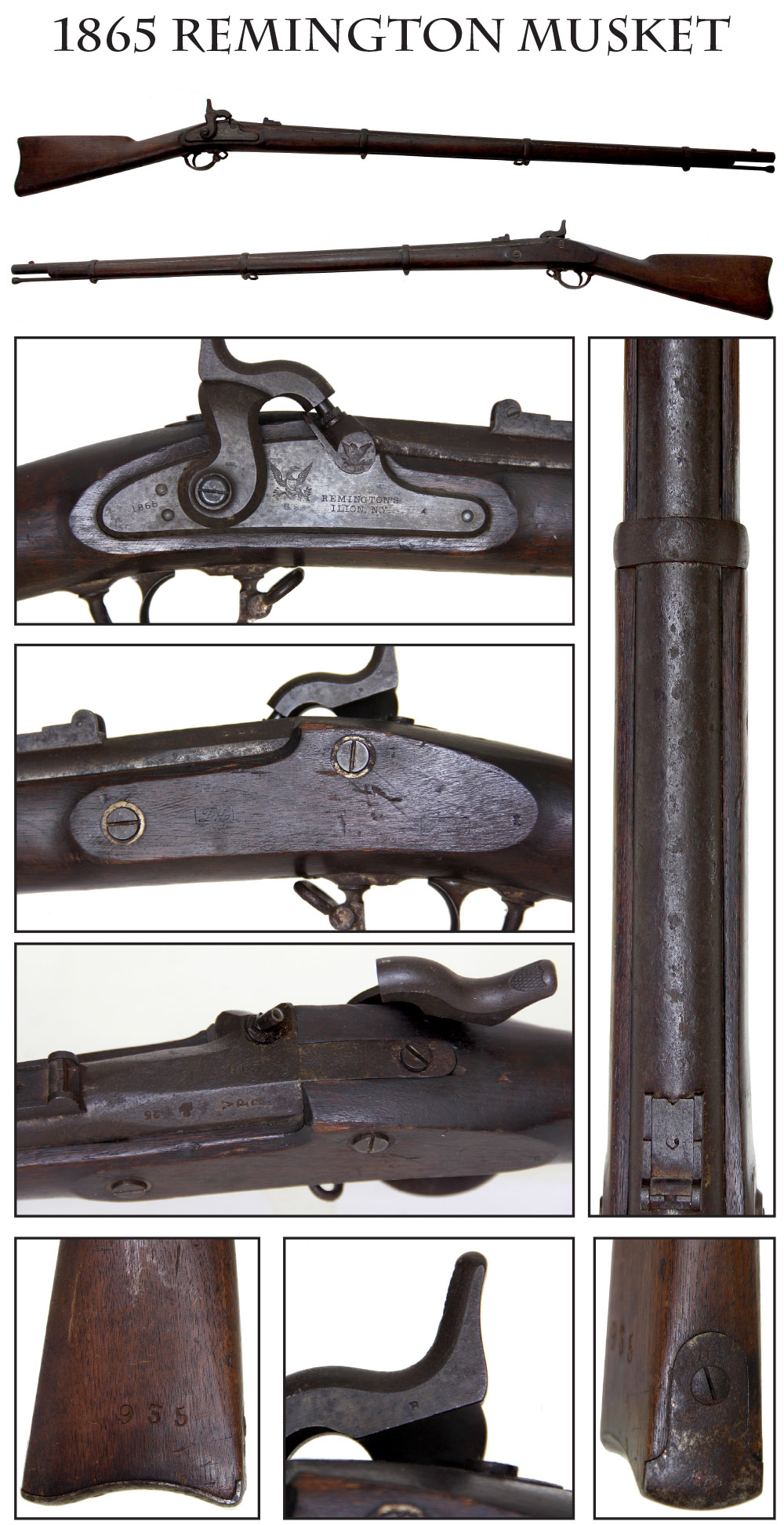
15-11-13 … Scarce Remington Contract 3-Band Springfield Pattern 1863 Musket …
Remington is believed to be one of only two makers to produce muskets that exactly followed the model 1863 Springfield specs. The other is the S Norris & WT Clements Made for Massachusetts musket. This Remington contract is a rare piece. The gun is in VG condition and has matching 1865 dates on the lock and barrel. The lock is crisp and gun metal grey in color. The barrel and bands are attic rust brown with some moderate pitting. This has the last pattern Springfield rear sight with one leaf and a peep hole in the center of the leaf. The stock has sharp edges, normal handling dings, and a clear cartouche of “OWA”. This is tight, solid, totally original and complete, and very scarce. Finding this late war Remington for sale is a rare event. It is one of the scarcest of CW contracts to acquire, and this is a wonderful example… ajgg
… $1,495.00
Click Here to E-mail Us!
Call us @ 419-842-1863

15-11-14 … German made Saxony cavalry saber 1840 to 1861 …
A good example of this German made sword and scabbard which was based on the British 1821 Pattern. 33.5″ slightly curved single fullered blade with early flat spine and a spear point. The sword is double edged for the last 8″. 3 branch steel hilt with rearward facing quillon. The guard is stamped F.A. 1884 1997. These markings are arsenal or armory markings, not dates. Shagreen covered grip bound with copper/brass wire. Steel back strap with ears fixed to the grip with a rivet. Domed pommel. The blade is nicely signed by maker Gebr. Weyersberg of Solingen.. Upper scabbard mount B527 and crown over FA. This is Friedrich Augustus II of Saxony. He reigned 1836 to 1854 (death). Separate throat is in place but lacks the two screws on the top and bottom edges. Still totally snug and secure. The blade and scabbard are free from rust and stains. Scabbard largely free from dents except for a smattering on the back side about eight inches above the drag. Very solid. The shagreen grip wrap shows expected wear but still solid and stable. In terms of Saxon military history that took place during Friedrich Augustus II reign… this saber may have been present during the 1849 May Uprising in Dresden in Saxony. Here is a synopsis from the lazy man’s best resource (Wikipedia) … “On 3 May 1849, the municipal guards were told to go home, but the town (Dresden) councelors organized them into defensive units to stop expected Prussian intervention. As the people’s anger grew, the government (Saxon) withdrew into the castle and the armory (Zeughaus), protected by Saxon troops. The municipal guards were undecided whether or not to support the people, who threatened to use explosives to get the government out. In response the Saxon troops fired on the crowd. Within hours the town was in chaos, with 108 barricades erected. In the early hours of 4 May 1849, the king and his ministers managed to escape and fled to the fortress of K nigstein.” A wonderful early cavalry saber at a highly affordable price … abe-mil
… $450.00
Click Here to E-mail Us!
Call us @ 419-842-1863

15-11-15 … 1834 Dated Harpers Ferry Model 1816 Conversion …
A good arsenal percussion conversion by the cone-in-barrel method of a flintlock musket. When it became clear the percussion system was the way of the future, flintlock muskets like this 1834 dated example were automatically sent for conversion by removing the external lock components, grinding the brass pan flush to the lock plate, changing the hammer and altering the breech to take a percussion nipple. The result was very serviceable arm that saw action well into the Civil War. This one has a very clear “Harpers/Ferry/1834” stamp behind the hammer and a Harpers Ferry eagle over US in front of it. The breechplug tang has a matching 1834 date as well. Some typical Harpers Ferry assembly codes on the parts and conversion re-assembly bench numbers stamped on the hammer and closed pan. The barrel is an even gray/brown overall with some pitting around the nipple from the effect of the percussion caps. The lockplate shows similar pewter tones with some faint case color. The triggerguard, buttplate, and sideplate have tight joins to the wood, but there is some gap on the breechplug and a slight crack running back through the top lock screw. There is some repair to an ancient crack at the wrist and a small piece of wood repaired behind the lock. Interestingly, the cone seat in the barrel is brass. All wood is solid and stable. Rod, swivels, bands, springs, bayonet lug all in place. Some soldier or owner initials on the left butt flat: a “JD” and also an “HY” with an “S” somewhat below. A very typical Civil War musket carried into the early battles by northern and southern volunteers. A musket with strong southern associations from the quintessential southern armory raided by John Brown, and whose machinery and weapons fell into Confederate hands at the war’s outset.Ramrod is a modern replacement … cej
… $650.00 – SOLD
Click Here to E-mail Us!
Call us @ 419-842-1863


15-11-16 … Pocket History of the US through 1815 …
A neat little history of the United States “from the first settlement as colonies to the close of the war with Great Britain in 1815,” published by Uriah Hunt in Philadelphia. Owner inscribed on the flyleaf: “Charles Wood/ Book / Monroe.” I don’t know anthing about Charles Wood, but I find the owner attribution less interesting than that this was what people were reading about the history of the country in a period we now regard as historic itself. This was published in 1835. When it was first read veterans of the Revolutionary War were still around, and Davy Crockett had not yet lit out for Texas and the Alamo. A neat little book. Somewhat rough condition from handling, but a very nice display piece with early western and exploration period gear … noco
… $40.00 – SOLD
Click Here to E-mail Us!
Call us @ 419-842-1863
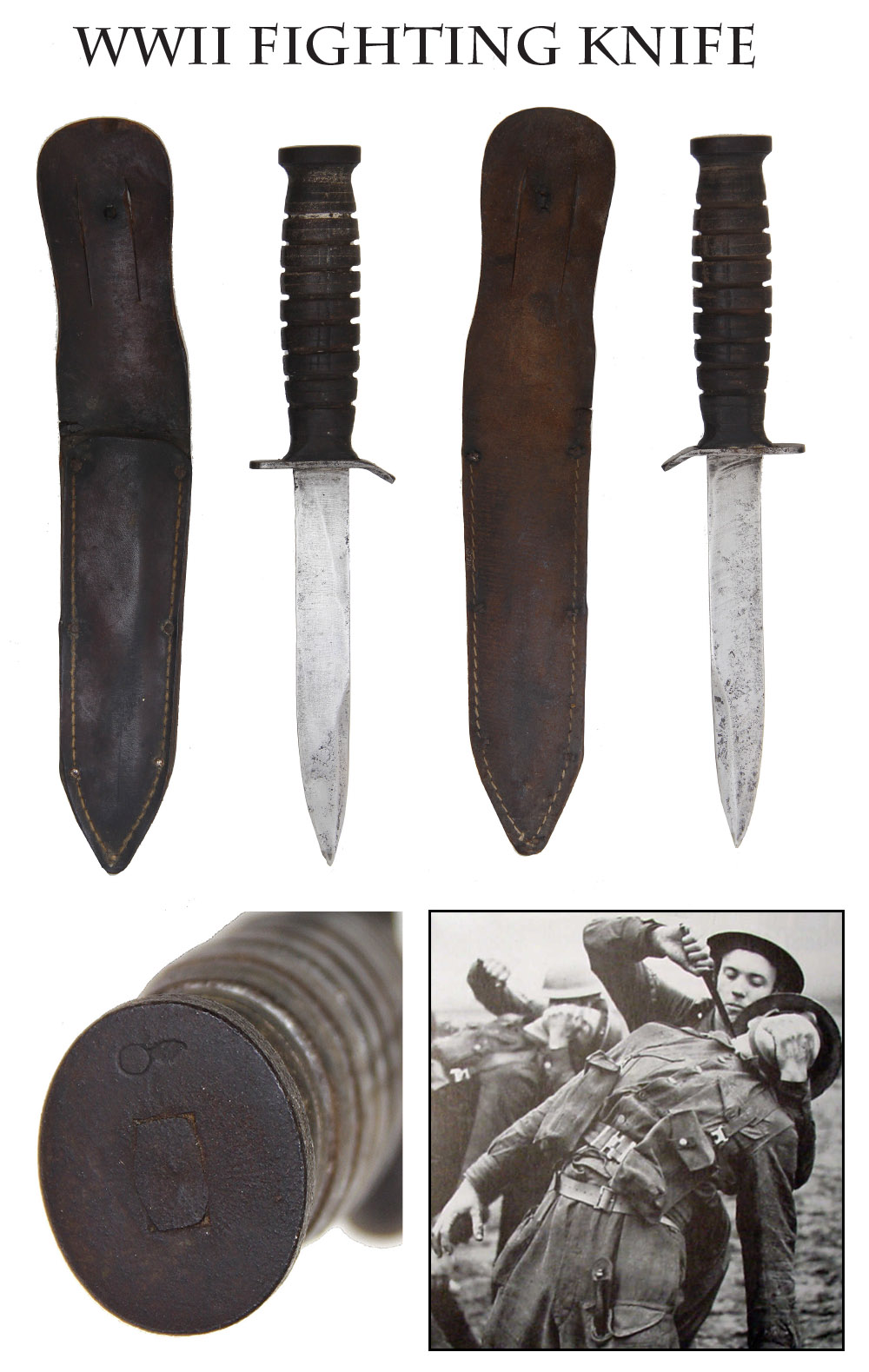
15-11-17 … World War 2 Combat Knife …
Well worn but very appealing WW2 fighting knife. Has ordnance bomb stamped into the flat pommel cap. This is housed in a leather sheath which may or may not be an army issue sheath … I am sure you will know. I’m too lazy to research it. Neat item that was brought into my shop a couple weeks back … wlk-in
… $85.00
Click Here to E-mail Us!
Call us @ 419-842-1863
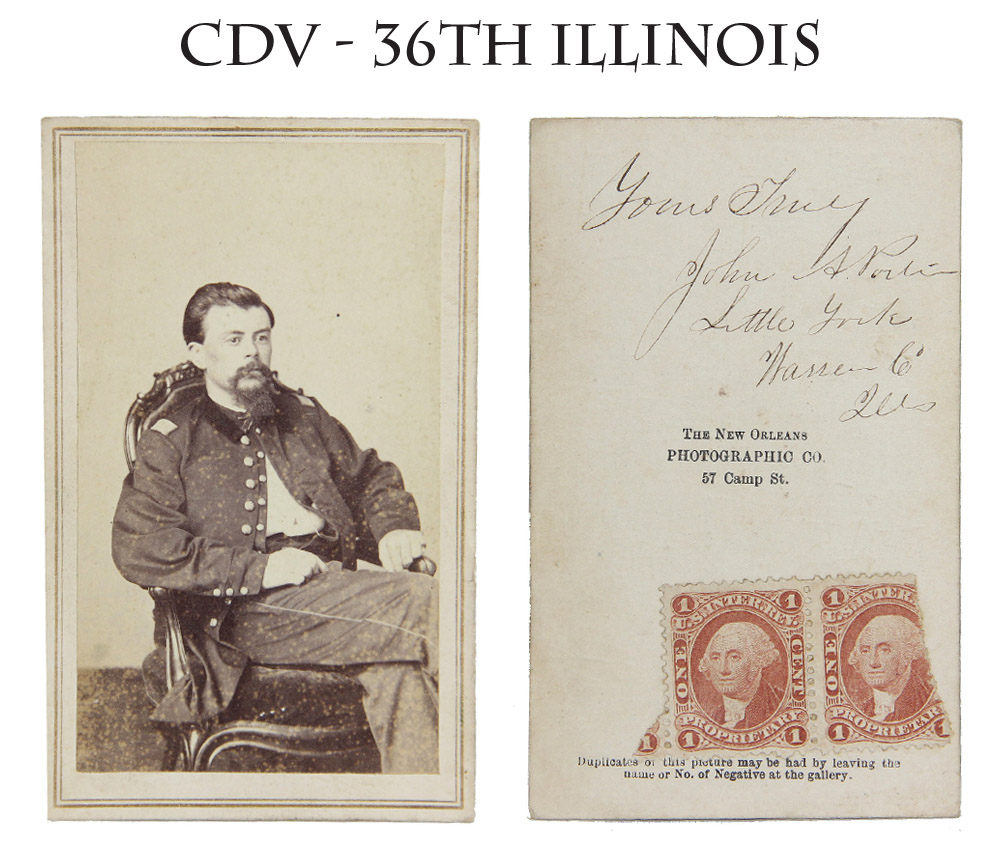
15-11-18 … John Porter – 36th Illinois – Injured at Resaca …
Three-quarter length seated portrait of a young officer with open frock coat, showing his shoulder straps and officer’s striped trousers. Two one-cent tax stamps on the reverse and “The New Orleans Photographic Co. / 57 Camp St.” backmark. Clearly signed in ink: “Yours Truly/ John A. Porter/ Little York/ Warren Co./ Ills.” Charles A. Porter was a 22 year-old teacher in Sumner, Illinois, when he signed up and lived in Little York after the war. He enlisted on 4/19/61 as a sergeant and mustered into Co. C of the 36th Illinois 9/23/61. He reenlisted as of 1/1/64 and mustered out 10/8/65 in New Orleans. He made First-Sergeant, Second Lieutenant, and eventually First Lieutenant on 3/13/65. The 36th was a fighting regiment serving in the Army of Southwest Missouri, Army of Mississippi, Army of Ohio and Army of the Cumberland. They suffered heavy losses: 11 officers and 193 enlistedmen in killed and mortally wounded alone, and over 700 including the wounded who recovered or lived long enough to be discharged. They saw action at Pea Ridge, Perryville, Stones River, Chickamauga, Missionary Ridge, Resaca, Dallas, Kennesaw Mountain, Atlanta, Franklin, and other blood-soaked fields.
Like Capt. Ward of the 74th Illinois, whose effects are presented above, Porter was injured in battle by the falling limb of a tree. As Ward’s case it was likely the result of an enemy artillery round: at Resaca the regiment was under artillery fire and on 5/15/64 Porter was hit by the limb of a tree resulting in partial paralysis. He was hospitalized in Chattanooga and Nashville, eventually returning to duty 11/10/64 at Pulaski, Tenn., in time for the fighting at Spring Hill, Franklin and Nashville. Though he served until mustered out in October, 1865, his injuries were severe. He applied for a pension in 1866 and was reported as permanently disabled in 1869. A soldier who continued to pay a price long after 1865 … be-16025
… $135.00 – SOLD
Click Here to E-mail Us!
Call us @ 419-842-1863
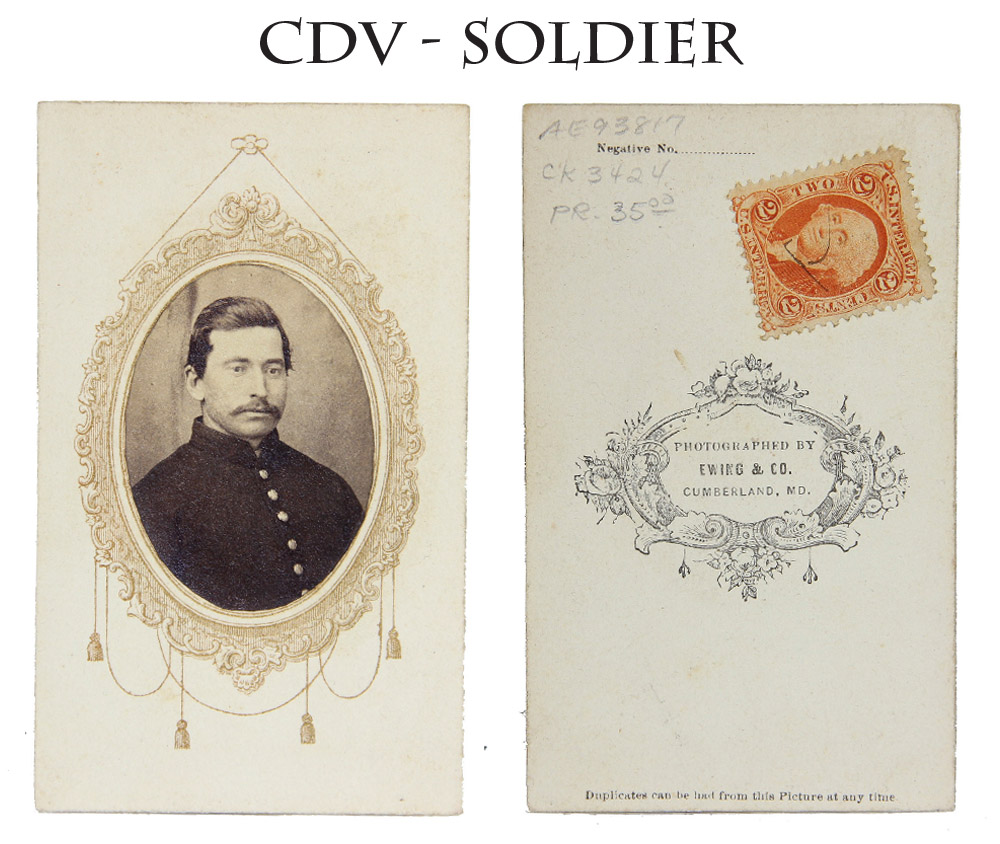
15-11-19 … Maryland Backmarked Soldier CDV – Oval Portrait …
Very clean oval trimmed albumen portrait on a CDV mount with printed picture frame border. Meant to imitate a portrait hanging on the wall, Ewing and Company of Cumberland, MD, mounted this soldier’s image on a pre-printed mounted showing a picture frame with tassels and hanging wire. Sepia toned, the image shows a young, well-groomed, man sporting an adult looking mustache and wearing an untrimmed military shell jacket or frock coat showing his brass buttons. A cancelled two cent tax stamp reflects the tax levied on luxury and fancy goods like photographs from the fall of 1864 to the fall of 1866. Clear Ewing backmark. His name is lost, but his uniform shows he fought for his country … noco
… $25.00 – SOLD
Click Here to E-mail Us!
Call us @ 419-842-1863
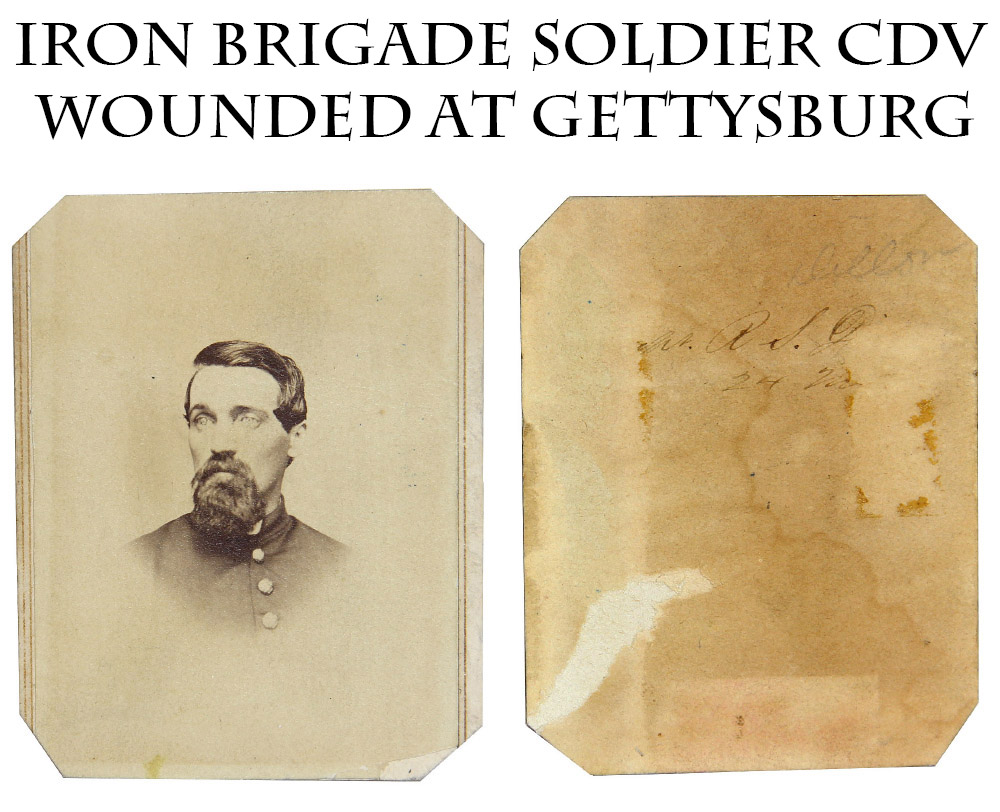
15-11-21 … Iron Brigade Wounded at Gettysburg / Captain Richard Dillon, 24th Michigan …
A clipped corner CDV vignette bust view of a famous Michigan Iron Brigade Member. His face is known in the regimental history and this carte is inscribed with his data on the reverse. On the reverse: the name “Dillon” is in period pencil at top right; a partially visible ink inscription is below with parts rubbed away [Ca]pt. R.S. D[….] and “24 M[….]” Dillon resided at Detroit and enlisted at age 32 on 7/26/62 as a First Lieutenant. He was commissioned in Co. A on 8/13/62. He made Captain 6/1/63. At Gettysburg on July 1, the Iron Brigade was among the first of the infantry to engage the enemy and suffered terribly in the fighting, losing some 316 killed and wounded out of 496 officers and men present. Henry Morrow, the regimental commander praised Dillon in his official report: “Capt. Dillon commanded his company with skill, and behaved very handsomely in skirmishing in front of McPherson’s woods,” and reported him “severely wounded in the leg.” Dillon recuperated sufficiently to rejoin the regiment in time for the Mine Run Campaign in late 1863, when he was reported to have appropriated a sword from a captured Confederate officer. In January, 1864, he was assigned to duty on the brigade staff, becoming Acting Assistant Inspector General, and served at that post until 8/5/64, when he went to Michigan on recruiting duty. Returning to the front in November, he was placed in charge of the division pioneer corps, remaining in that post until he returned to the regiment in May, 1865 and was mustered out on 6/30/65, earning a brevet rank of Major to date 4/9/65. He returned home after the war and died in Detroit in 1886. Of course, Dillon also saw action at Fredericksburg, Chancellorsville, Wilderness, Spottsylvania, Petersburg and many other engagements. His presence in the Iron Brigade on the opening day of the Battle of Gettysburg, however, is hard to surpass in the imagination … g
… $1,450.00
Click Here to E-mail Us!
Call us @ 419-842-1863

15-11-22 … Charles Wheeler Tyrell – 137th Illinois CDV …
Studio shot of a young man in a nine-button jacket with forage cap and guantlets holding a cocked pistol across his chest, though he wears no belt or holster, so it’s likely a prop to give him a more warlike air. G. Moses, Quincy, Illinois, backmark. Period ink inscription: “Charles Wheeler / Tyrrell 17 / Oct 30 1865.” No tax stamp. Charles Wheeler Tyrell (slight spelling variation) enlisted in Clayton, Ill., on 5/14/64 and mustered into Company B on 6/5/64. The regiment mustered in at Camp Wood in Quincy for one hundred days service and the photo was thus likely taken shortly after signing up, thus explaining the lack of a tax stamp, and inscribed later. The regiment was sent to Memphis and assigned to the 4th Brigade, District of Memphis, doing picket duty on the Hernando Road. This was not quiet duty, however. They lost 1 officer and 17 men killed or mortally wounded during their service, 9 killed and 2 wounded on August 21 alone. At least another 16 were wounded on other occasions and the CW data lists 69 as taken prisoner. This was a hundred-day unit that saw some action. Tyrell survived to muster out with the unit on 9/25/64 … ej-17193
… $150.00 – SOLD
Click Here to E-mail Us!
Call us @ 419-842-1863

15-11-24 … 1814 Dated Flintlock Harpers Ferry …
Nice War of 1812 date on the lockplate of this veteran: “Harpers/Ferry/1814” aft of the hammer, and a very visible Harpers Ferry style eagle forward. Deep overall pitting to the barrel, shallower on the hammer and plate, but not affecting the lock marks. Still sharp edges to the wood though around the lock apron and on the offside and the fit of the metal to the wood is tight. Barrel is full length and has not been sporterized. The front sight and bayonet lug are still in place. Swivels and bands in place. One band shows an old fracture across the top, but there is no damage to the barrel. Missing the ramrod, which could probably be found with a little searching. Original flint, needless to say. This old soldier was just used and then put away. Harpers Ferry followed its own path in developing its muskets, which are distinct from the Springfield products. This falls into Flayderman’s Type III category, made starting in 1812. This pattern had a strengthened stock, did away with the serial numbers, and changed the triggerguard finials. The production ran to 10,400 muskets that year, but ours falls into the early part of the run with its 44 3/8 inch barrel rather than the later 42 inch. This makes it a good candidate for some of the skirmishes and full scale battles in Maryland that year: Leonards Creek, Queenstown, Nottingham, Bladensburg, Caulk’s Field, North Point, and of course Fort McHenry. A real veteran of the “Second American War for Independence.” Find another real 1812 musket in “original flint” priced at … no rod … noco
… $950.00 – SOLD
Click Here to E-mail Us!
Call us @ 419-842-1863

15-11-25 … Starr 1818 Pattern Cavalry Saber …
Nathan Starr was a prolific supplier of arms. Following his War of 1812 contracts, he got a contract in 1818 for 10,000 cavalry sabers from the US government, which he delivered between 1820 and 1822. Ours has the original black-japanned iron scabbard with two carrying rings, and black-japanned iron hilt with leather covered wood grip. About 40% of the leather remains on the wood core, mostly on the right side, but the wood is solid and the leather could be replaced if you wanted. Very sharp “US/P/JW/N.STARR” stamp at the ricasso, just a little light on the end of Starr’s name, indicating the inspection was done by Joseph Weatherhead. Blade has a good edge and point. Smooth gray in tone with darker gray spots and areas, but relatively evenly distributed … cjj-mil
… $495.00 – SOLD
Click Here to E-mail Us!
Call us @ 419-842-1863

15-11-26 … Model 1860 Italian Cavalry Saber by Schnitzler and Kirschbaum …
We are used to seeing S&K products for the American market, but the German makers were happy to supply arms elsewhere as well. Here’s a model 1860 cavalry saber made by the firm in time for use in the later battles of the “Risorgimento” or “Resurgence,” a series of wars that finally unified Italy. Very good iron hilt and steel scabbard. Full leather and wire wrap to the grip, pad still present under the guard. S&K stamp on one side of the ricasso and an Italian inspector acceptance stamp on the other. Blade has a good edge and point and is largely in the bright. Scabbard shows more gray spots over bright, but matches the hilt in an overall subdued pewter gray tone. My friend Jackie, a sharp Florida dealer, recently had one of these with a world-class brown ink tag that it had been taken from the dead body of cavalryman on one of the important battlefields. This is a hefty sword meant for business … bjj-mil
… $325.00
Click Here to E-mail Us!
Call us @ 419-842-1863
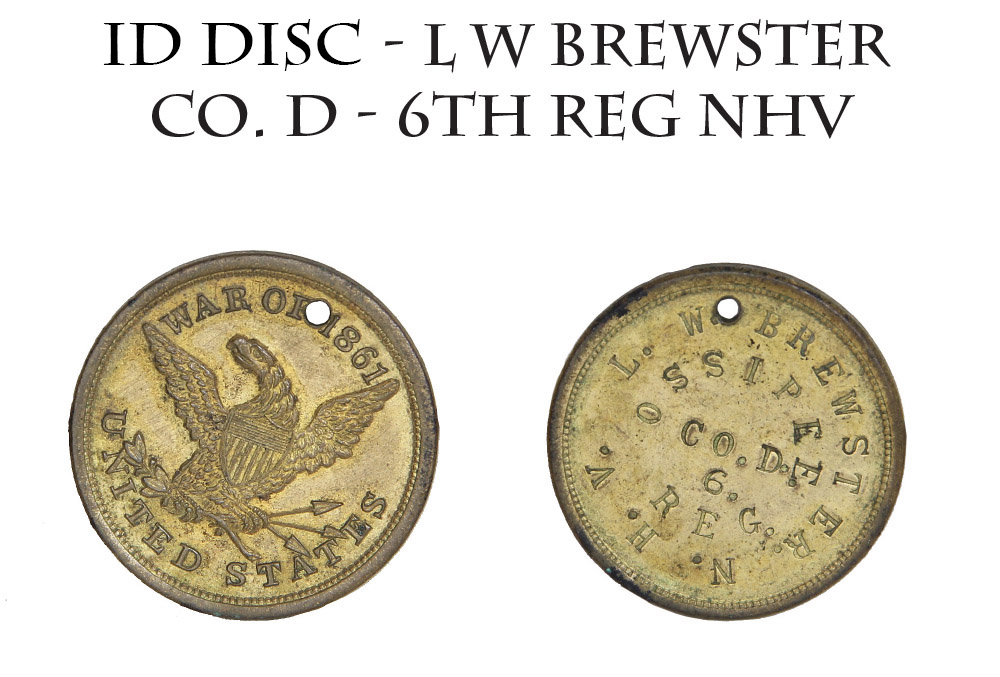
15-11-28 … North Carolina Service ID Disc of Leonard W. Brewster, 6th New Hampshire … Owner Died in Service! …
In the days before army issue dog tags soldiers had to provide for themselves and A variety of types were available from sutlers, jewelers, camp peddlers and the like. Here is the classic standard example and the most popular. It is the WAR OF 1861/EAGLE pattern. This one was sold to Corporal Leonard Brewster, who had enlisted from Ossipee, NH, at age 18 on 10/28/61 and mustered into Co. D of the 6th NH as a corporal on 11/27/61. He had his identification disc stamped with the following information: L.W. Brewster/ N.H.V./ Co. D / 6/ REG./OSSIPEE. The disc was also pierced with a small hole to permit it to be hung from a pin that would fasten to coat or jacket. The 6th left the state for Washington in late December, 1861, and was assigned to Casey’s Provisional Division for little more than a week before being assigned to take part in Burnside’s Coastal Expedition to North Carolina in early January. The regiment spent time on Hatteras Island and Roanoke, taking part in some expeditions in late March and early April. Corporal Brewster, however, did not live long. The camps were considered to be unhealthy and he succumbed to disease on Roanoke Island 4/7/62. Like any soldier who died in service, he was a sacrifice for his country, cold consolation perhaps for his family back home who were left to treasure a few artifacts like his identification disc. A touching personal item in excellent condition … 6th NHV … died during Civil War … tdbex-16985-150106
… $750.00
Click Here to E-mail Us!
Call us @ 419-842-1863
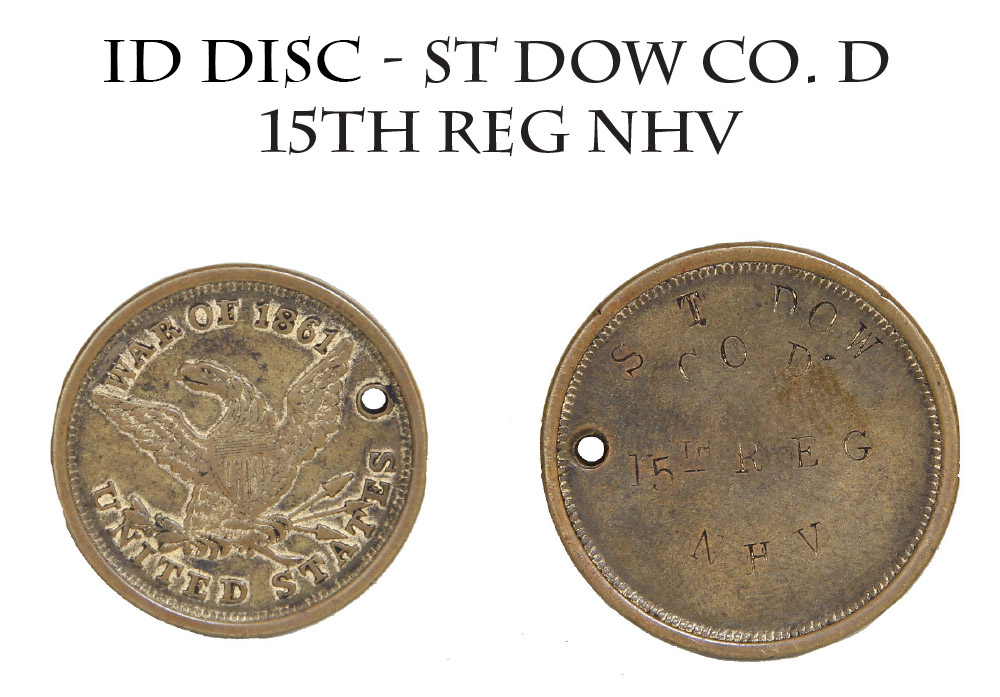
15-11-29 … Identification Disc of Samuel T. Dow, 15th New Hampshire / Served Two Hitches …
The 15th NH was one of the regiments recruited for nine months service in late 1862. Many understood the duty was to be auxiliary service to enable troops already in the field “to strike the rebellion a staggering and fatal blow,” the regimental historian’s words. Such was not the case. These 9 month regiments frequently found themselves in as deadly circumstances as any. Samuel T. Dow resided in Northwood and was 22 when he enlisted on 9/12/62 as a private and mustered into Co. D of the 15th NH on 10/8/62. The regiment was assigned to the Department and Army of the Gulf, where it became part of the 19th Corps and found itself taking part in the siege of Port Hudson from late May until early July, 1863. It took part in several assaults and lost 30 of its men killed or mortally wounded during its service. At some point Dow acquired this WAR OF 1861/ EAGLE disc and had the following brief information stamped on it: S T DOW/ CO D/ 15th REG/ NHV. Dow survived to muster out with the regiment 8/18/63. He either liked army life, or the prospect of a bounty, and reenlisted in the 18th New Hampshire as a sergeant in Co. I on 2/28/65. This was a late war regiment that served in the 9th Corps during the Petersburg Campaign, losing 1 officer and 4 enlisted men killed or mortally wounded. Dow’s luck held, however, and he survived once again to muster out on 7/29/65 … zfbe-17184-150806
… $795.00
Click Here to E-mail Us!
Call us @ 419-842-1863
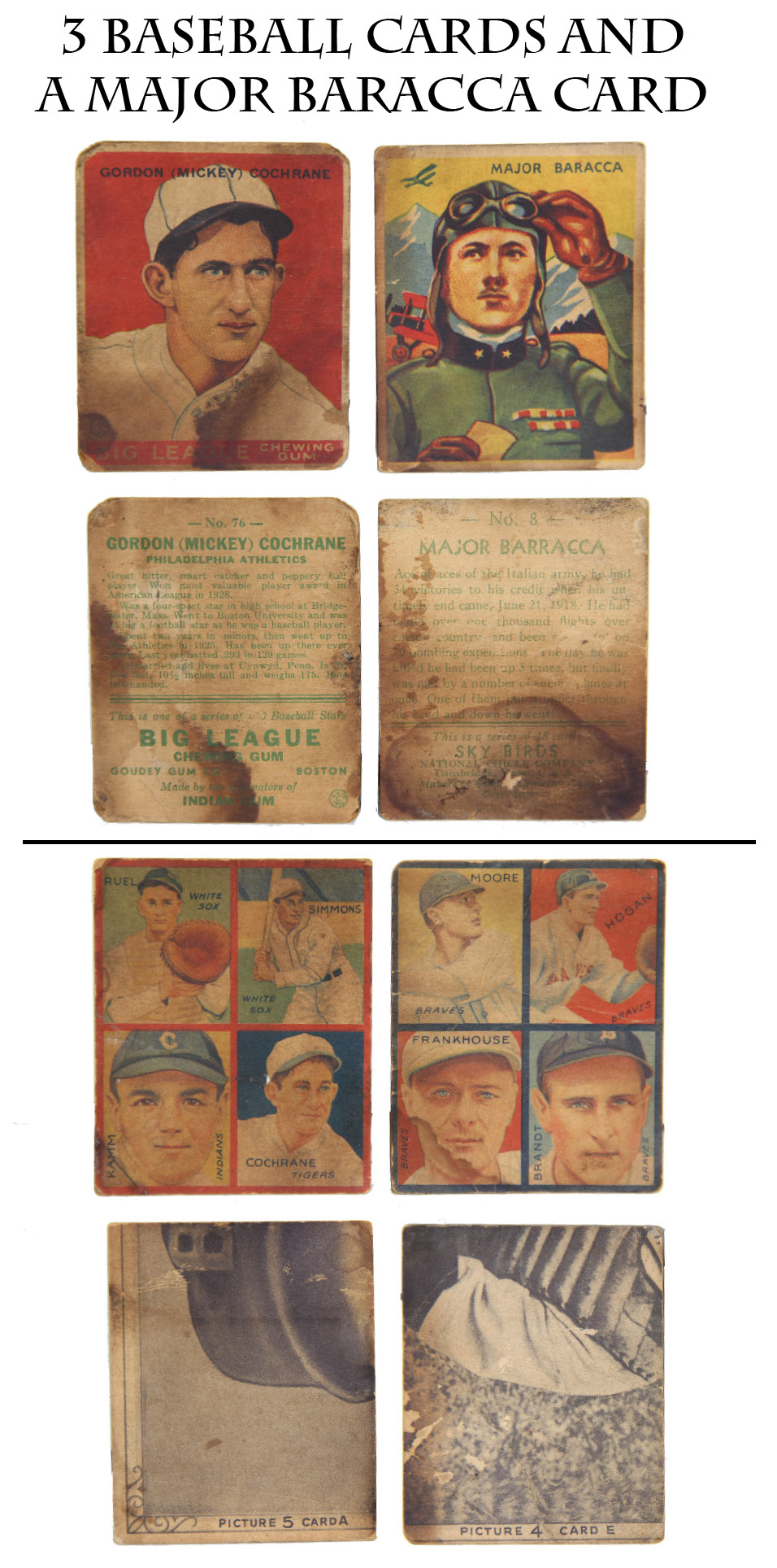
15-11-30 … 1930s Baseball Cards Etc. …
A local fellow brought in some old stuff and these four tired-out old cards were tucked in a tired old cigarette case. I looked them up on line and in top condition some are quite expensive. The Cochrane baseball card runs from a hundred dollars in good condition to over six hundred in excellent. Ours is probably fair or poor condition. The baseball cards with four pics on each are also somewhat scarce items with decent value in top condition (which these are not). The flyer card dates to 1934 and is quite common on ebay. At any rate… A neat little lot of artifacts from the era of my dad’s childhood. (My old man turned 85 this month and still doing fine.) For the lot
… $65.00 – SOLD
Click Here to E-mail Us!
Call us @ 419-842-1863


15-11-31 … Exceedingly Rare Package for Confederate Rifle Ammunition …
In the 45 years that I have collected and traded in Civil War antiques this is the first Selma Arsenal ammo pack I have owned, and it is a dandy with crisp clear lettering. A top shelf CS display item. This is just the wrapper, there are no original cartridges inside. The label tells the story… 10 Cartridges caliber .69 Round Ball Smooth Bore 1863 etc… If you are creating a display of Confederate infantryman’s effects, this would look super laying next to an 1816 conversion or 1842 musket. The only one I have ever owned … e
… $1,150.00
Click Here to E-mail Us!
Call us @ 419-842-1863
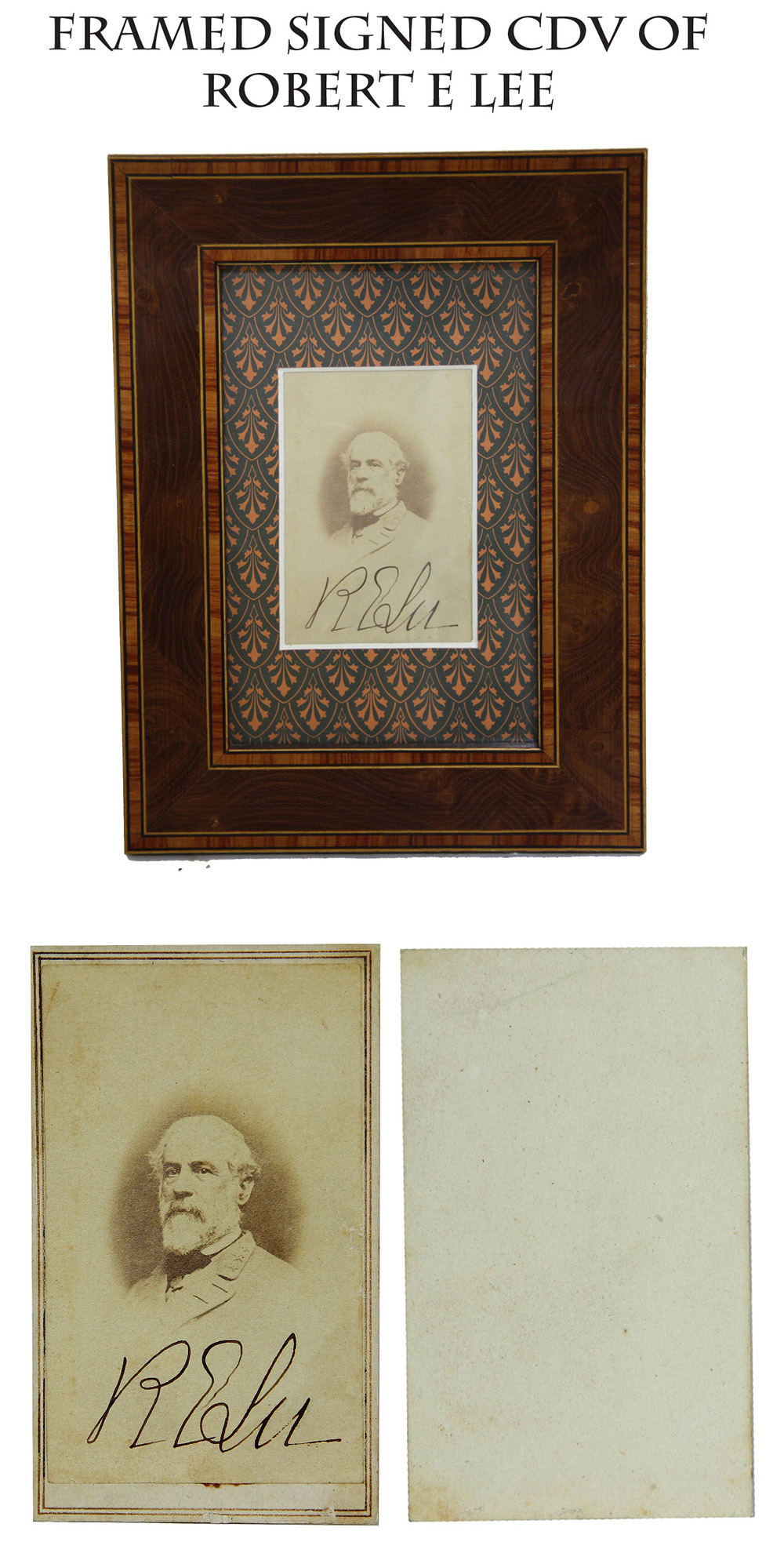
15-11-32 … Superb Autographed Photograph of Robert E Lee in Uniform …
Iconic CDV view of uniformed Lee, boldly signed by him in brown ink. This is a vignette version of Vannerson’s famous 1864 photo of Lee in uniform. Reportedly the favorite image of Lee himself and his family. After the war Lee was inundated with requests for his autograph. He was arguably the most respected and revered of all Civil War generals and everyone wanted a memento. He signed a great many CDV photos of himself in civilian dress, and far fewer of himself in uniform. The most sought images by collectors are uniformed views signed on the front. Well. this is about as top-shelf an example of that CDV as I have ever encountered. When first taken the image undoubtedly was meant to convey the character and strength of “Marse Robert” as a successful commander. By the time he signed it, it was an image of a lost cause and nobility and dignity in defeat- the vignette effect a suitable parallel for some of the popular southern cards showing CS flags and a setting sun.
This has a wonderfully bold ink signature “R E Lee” centered at bottom. Dead real and in excellent condition. One of the holy grails for a Civil War collector. Nicely housed in a modern display frame. A near identical view sold at Heritage auction on Dec. 2nd 2006 for $8,962.50. They sold a signed civilian view for $4500.00 in June of this year. The quality of the autograph on this carte stands as among the best available … bc
… $4,500.00 – SOLD
Click Here to E-mail Us!
Call us @ 419-842-1863
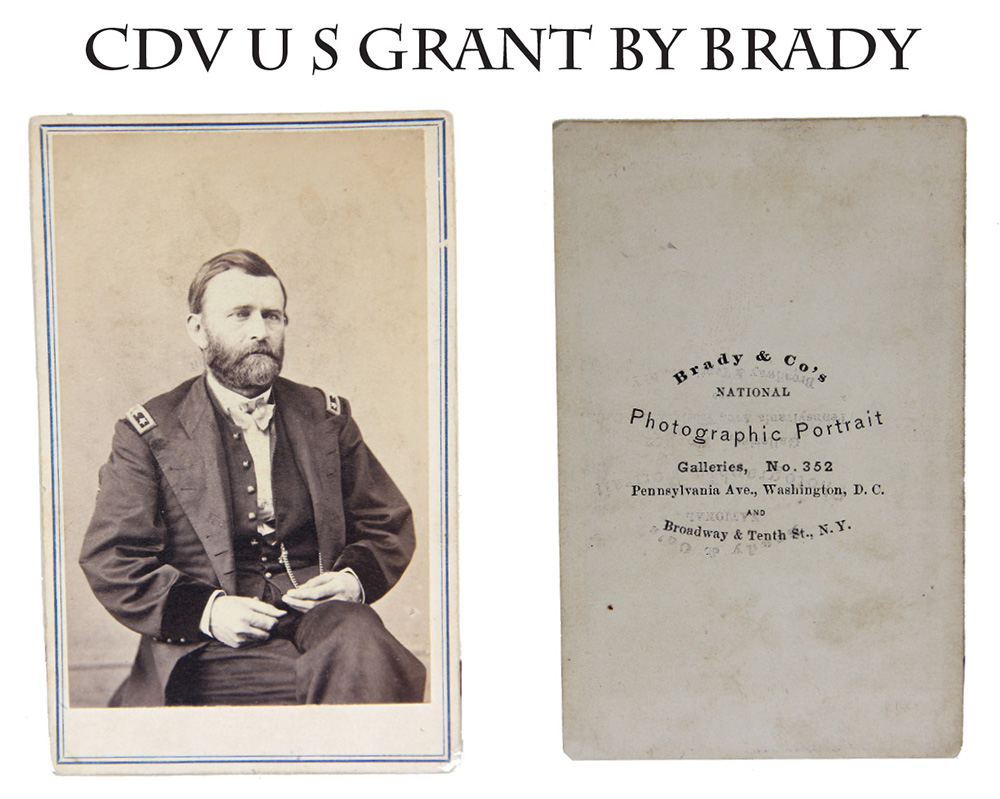
15-11-33 … Brady CDV of Grant as Lieutenant General / Rare Pose …
Clear seated two-thirds length portrait of Grant wearing an open officer’s frock showing his vest and watch chain, the stars of his Lieutenant General’s shoulder straps visible on either shoulder. Blue line border card with “Brady & Co’s National Photographic Portrait Galleries …” backmark. Grant’s rank and lack of a tax stamp point to 1864-1866 as the time frame. Grant was probably the most photographed figure of the nineteenth century. There have been a few attempts to catalog photos of him. I doubt anyone has gotten them all. A nice view of the savior of the Republic. A view of him seldom seen for sale … bge-heri
… $375.00 – SOLD
Click Here to E-mail Us!
Call us @ 419-842-1863

15-11-34 … Signed CDV Career U.S. Regular Army Surgeon John E. Summers – Mexican War, Civil War and Indian Wars! …
Served 1847 to 1886. A character-filled portrait of bearded officer in double breasted frock with shoulder straps in a vignette mid-chest view. Van Stavoren, Nashville, back mark. Signed in ink “Jno. E. Summers / Surgn. USA” … This is John E. Summers, who was a surgeon in the US Army (the usual meaning of “USA” in period inscriptions.) He was from Virginia and became an Assistant Surgeon during the Mexican War, on 12/13/47. He made Major and Surgeon 5/21/61; Lt. Col. and Medical Inspector from February to October, 1863. His record in Heitman picks him up again as Lt. Col. and Surgeon in 1880, and Colonel and Surgeon in 1885, retiring in 1886. One published biography relates that he served on the Indian frontier until 1862 and his assignment in 1863 was as Medical Inspector of the Department of Tennessee, and that he served under Grant at Vicksburg. This ties in well with the Nashville backmark of the photo. After the war he was medical director of the department of the Dakotas and then of the Platte, on the staff of Hancock and Crook respectively. Most medical doctors who served in the army did so as volunteers and returned to civilian practice when their war was over. Summers wasn’t just an M.D., he was also a career soldier. One heck of a lot of history packed into this CDV … gj
… $325.00
Click Here to E-mail Us!
Call us @ 419-842-1863

15-11-35 … Artillery Corporal Chevrons …
We are used to seeing the surplus Civil War worsted wool chevrons that survived in large numbers in late war surplus stocks. Just as evident in period photos, and more evident on the few extant NCO coats, are various private purchase chevrons such as these. Here is a wonderful pair of red, “gull-winged” artillery corporal stripes that are a flat scarlet wool sewn on a dark blue backing. The chevrons are standard large size CW patterns which cover the entire front half of the sleeve, leaving some extra if the soldier wished to hide the ends by inserting them into the seams of the sleeve. Excellent color and very attractive. These have a
“great look”.
Corporals and sergeants were in charge of the individual pieces in an artillery battery, with officers in charge of sections, the caissons, and the battery as a whole. This is a real fighting rank … noco
… $475.00 – SOLD
Click Here to E-mail Us!
Call us @ 419-842-1863

15-11-37 … Near Perfect 1863 US Marked Horse Bit …
The pictures tell the story. Superb condition, great markings, both US bosses are beautiful
… noco
… $295.00 – SOLD
Click Here to E-mail Us!
Call us @ 419-842-1863

15-11-39 … Lieutenant D.R. Smith – 50th New York …
Nicely posed CDV of a Civil War officer by R.A. Lewis of New York City. Bearded officer wears a sash and sword belt, his left hand holding his cross-strap and his right hand on the hilt of his unsheathed officer’s sword. His slouch hat with an officer’s embroidered hunting horn plainly visible sits on the balustrade next to him.
The identification was furnished by a previous collector on a typed piece of paper. I have no reason to doubt it: “Lt. D.R. Smith.” There are two NY officers with that first initial and no middle initial in the records, but only one “D.R.,” who is David R. Smith of the 50th New York. That regiment, later an Engineer unit, was originally an infantry outfit. Smith enrolled at age 28 at Willets Point (near NY City) on 6/17/61 to serve two years and mustered in as 1st Lieutenant of Co. D, 6/25/61. He was dismissed 10/10/61. He managed to get the dismissal revoked 8/27/62 and was granted an honorable discharge as of 10/10/61, the original date of his dismissal. There is a story of some sort here. Whatever it is, it makes me trust the identification more. … ej-17193
… $75.00 – SOLD
Click Here to E-mail Us!
Call us @ 419-842-1863
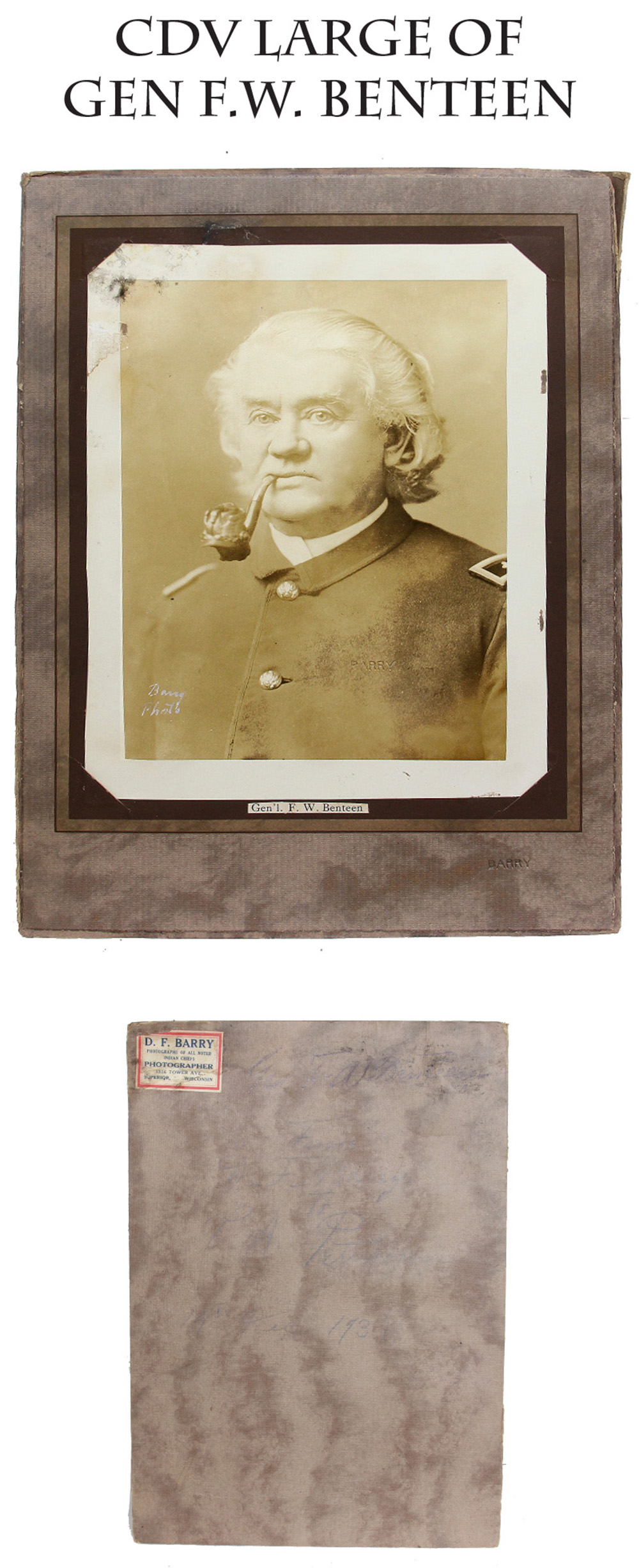
15-11-40 … D.F. Barry Portrait of William Benteen, 7th U.S. Cavalry, as Brigadier General …
Measuring roughly 6 x 8 inches, in Barry’s folding card stock preserver with an inscription by Barry. Signed in the negative: “Barry/ Phot’s” also impressed into the photo “BARRY”, and a printed label underneath “Gen’l. F.W. Benteen.” D.F. Barry photographer label from Superior, Wisconsin, on upper left of the folding preserver case. Barry worked with Orlando Goff in the Dakota Territory and Montana in the 1870s and 1880s and is well known for his portraits of western personalities, particularly of Indians. He moved to Superior, Wisconsin, in 1890. This image was printed by Barry, circa 1920s 1930s, directly from one of Barry’s 1890s negatives. The front of the folder- preserver bears a note “From D.F. Barry to P.F. Peterson 14 Dec. 1931.” Some minor spotting or dirt upper left of image margin, slightly touching edge of portrait, but not affecting figure. Benteen wears an undress blouse with brigadier general shoulder straps, his hair worn long and combed back over his ears, a heavily carved pipe in his mouth. Benteen served in the 10th Missouri Cavalry during the war, fighting at Wilson’s Creek, Pea Ridge, Vicksburg, and elsewhere. He went in as a lieutenant and made it to Lieutenant Colonel of that regiment and then Colonel of the 138th US Colored Infantry at the end of the war. In 1866 he was appointed Captain in the regular army and assigned to the 7th Cavalry. Never a fan of Custer or his supporters, Benteen recalled once checking to see if his revolver was loaded before announcing to Custer that he (Benteen) had written the anonymous letter to the newspapers that criticized Custer’s abilities and which had sent Custer into a rage. Custer replied “Colonel Benteen, I’ll see you again!” At the Little Big Horn he was sent on a scout with three companies to the left of the column, but returned in time to save the shattered remnants of Reno’s battalion. Whether he could have or should have pressed on to join Custer’s companies is still debated 140 years later. Benteen retired from the army in 1888 after a minor scandal, but was brevetted Brigadier General in 1890. He died in 1898. A good “from life” portrait of a famous Indian War US cavalry officer by one of the best known photographers of the American west … lot2403-119405
… $350.00 – SOLD
Click Here to E-mail Us!
Call us @ 419-842-1863
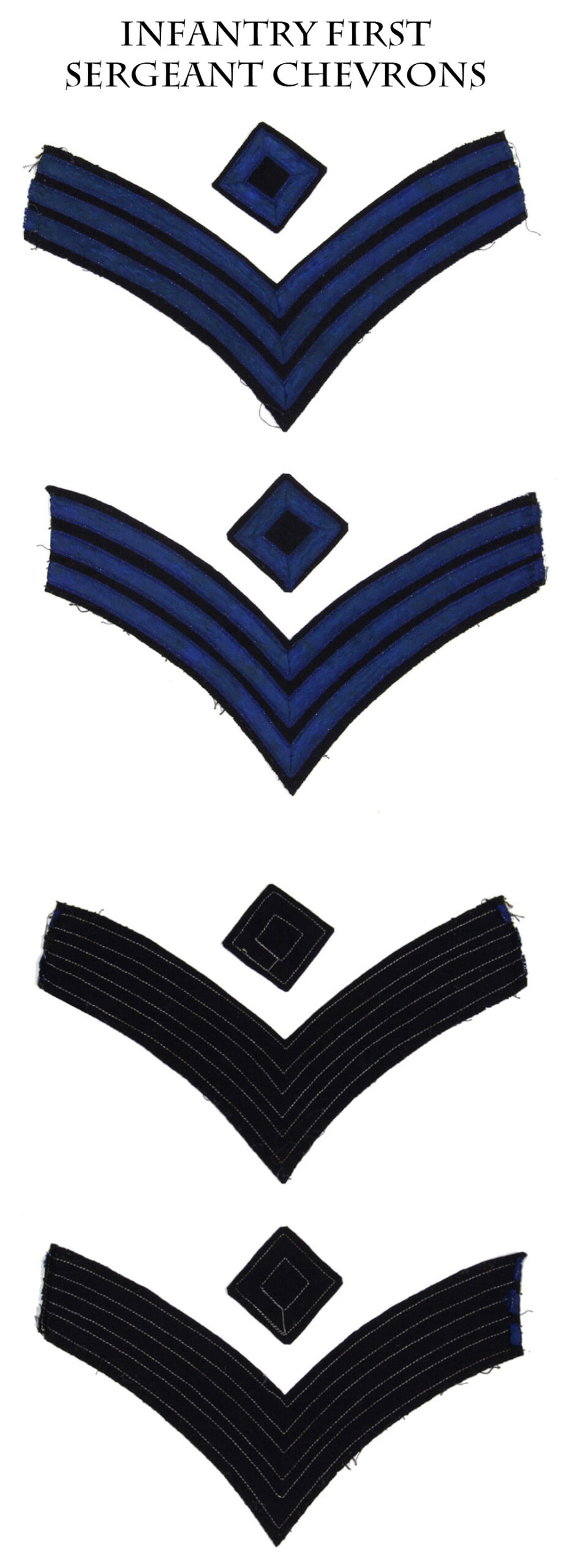
15-11-41 … Infantry First Sergeant Chevrons …
Nice set of “gull-winged” medium blue chevrons showing three stripes for a sergeant and having the separate diamond shaped lozenges that designate these as the company Orderly or First Sergeant. The First Sergeant was the senior NCO, the man who actually ran things in the company on a daily basis. He was the one assembling details, calling roll and performing a hundred other tasks. General Kautz, in his 1864 manual on Customs of Service for Non-commissioned Officers actually spends 18 pages and numerous numbered paragraphs on their duties and responsibilities. These guys had to be capable and of strong character to exercise the necessary discipline and control. These chevrons show some loose threads at the ends indicating they were mounted on a jacket or coat at some point. The stripes are a medium blue silk rather than the light-blue worsted wool we often see on the surplus chevrons. These are machine sewn utilizing a lockstitch machine (invented in 1832). The lock stitch utilizes two rolls of thread keeping each separate on their own side of the material. Here we have blue thread on the chevron side, and cream thread on the back side. A nice period set and scarce with the separate lozenge still with them … 495pr
… $495.00 – SOLD
Click Here to E-mail Us!
Call us @ 419-842-1863
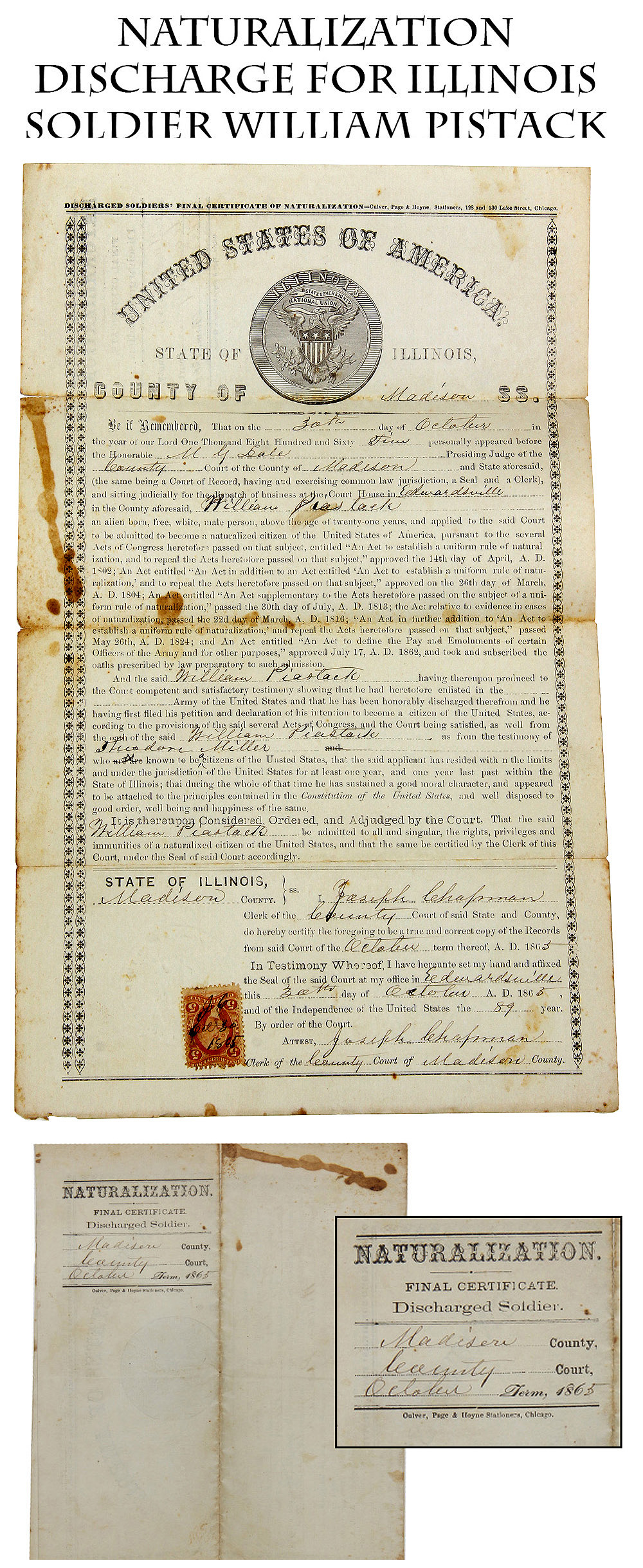
15-11-42 … William Pistack, 10th Illinois Cavalry, Becomes a U.S. Citizen …
A nicely filled out certificate of naturalization filed in Madison County, Illinois on Oct. 30, 1865, to certify that William Piastack had been honorably discharged from the US army, was of good moral character, etc., and was granted citizenship by Judge Lale of the county court under various acts of Congress. Piastack (or Piostack) was residing in St. Jacobs when he enlisted on 10/18/61 as a corporal and was mustered into Co. F of the 10th Illinois Cavalry on 12/31/61. He reenlisted 1/3/64 and was mustered out as a sergeant on 10/9/65. The regiment, or portions of it, served in Missouri, Arkansas and Louisiana, seeing action in a number of expeditions, scouts and skirmishes at places like Cane Hill, Marshfield, Clark’s Mills, Cotton Plant, Bayou Meto, Bayou Fourche, Bayou Des Arc, etc. They also took part in the capture of Arkansas Post and of Little Rock. The regiment reenlisted and retained its designation, becoming the 10th Illinois Veteran Cavalry in 1865. During their service they lost 1 officer and 24 enlisted men killed or mortally wounded. An interesting western theatre regiment
… $35.00 – SOLD
Click Here to E-mail Us!
Call us @ 419-842-1863
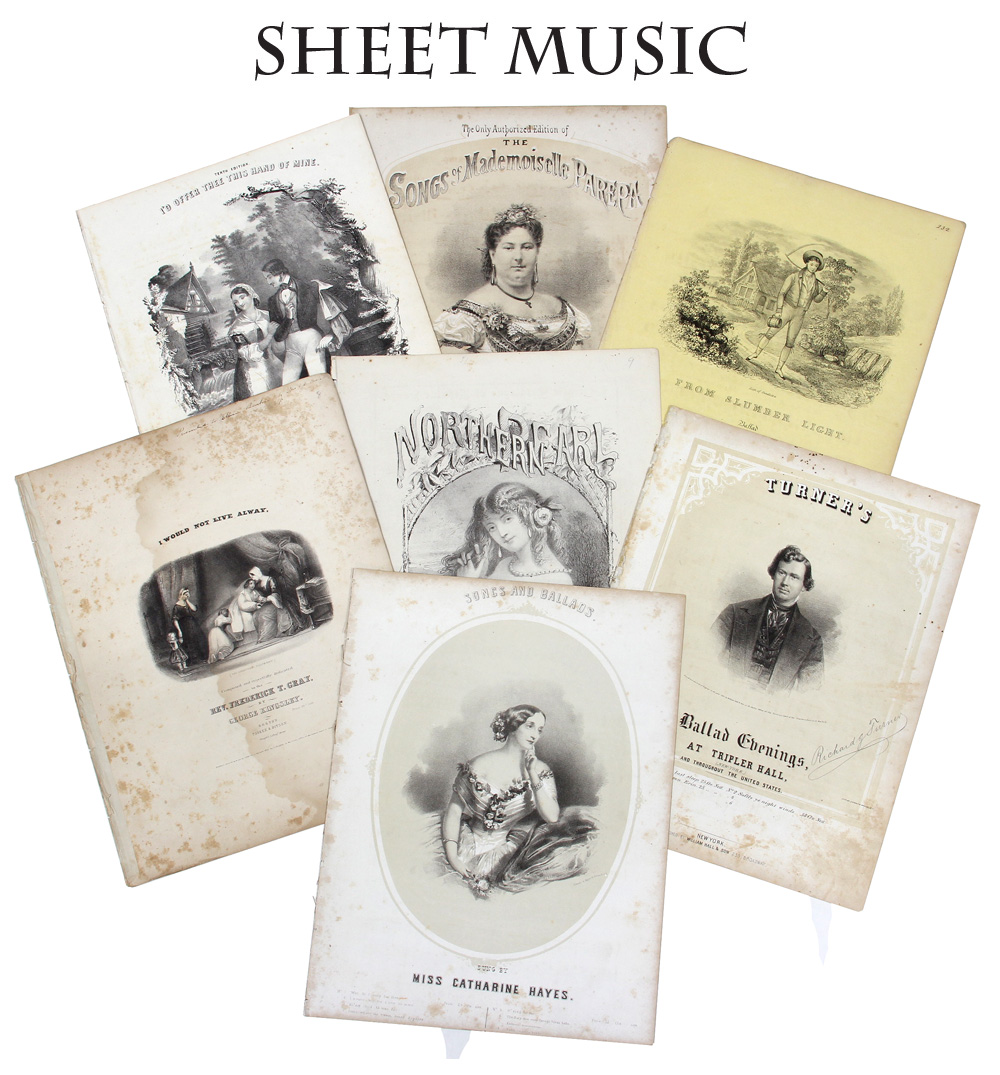
15-11-43 … Sheet Music with Good Graphics …
I have a nice selection of Civil War or slightly earlier sheet music with nice graphics on the covers. I believe I have around 30 pieces. Aside from “Home Sweet Home” the titles, and lyrics, will probably not be familiar. (You can be the first one on your block to introduce these CW tunes to the neighborhood.) They tend toward the romantic and sentimental. Many are reminders of the fragility of life in nineteenth century America, and they would look good framed or even in a collection as examples of life on the homefront. There are certainly many stories in soldier letters of visits to local houses during lulls in campaigning where singing in the parlor was a welcome break in army life. For those stationed on the frontier it was one of the few wholesome recreations available to stave off boredom. Each piece has a nice cover graphic … noco …
Priced each $15* … Two for $25* … Five for $65*
*my choice
Click Here to E-mail Us!
Call us @ 419-842-1863
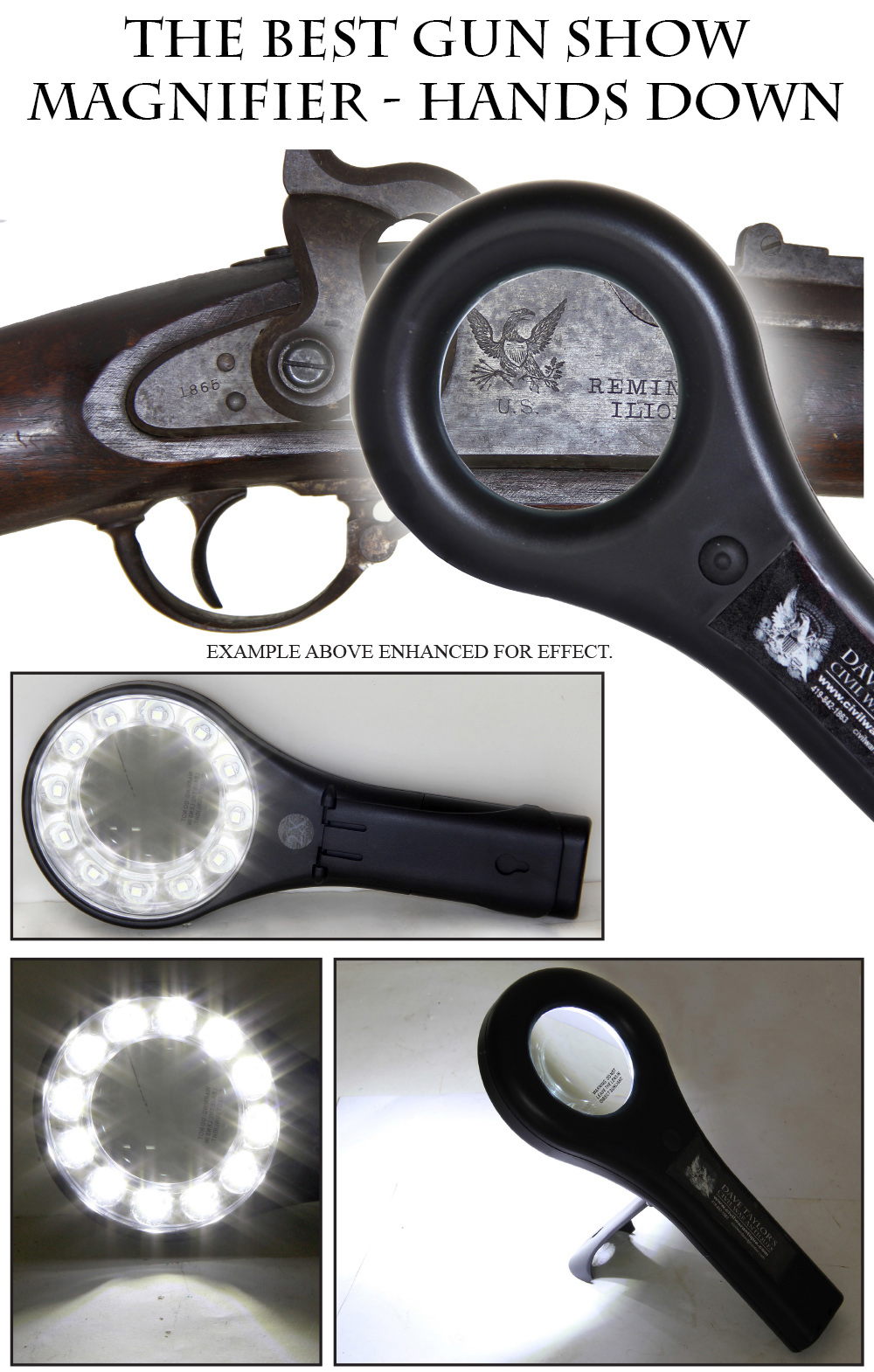
15-11-44 … INCREDIBLY EFFECTIVE LIGHTED MAGNIFYING GLASS / PERFECT FOR INSPECTING ANTIQUES …
You have undoubtedly seen collectors at the shows running around with one of these magnifying glasses in their hand. There’s a good reason … they are SUPER! Months ago I bought one for myself and loved it. Then the local guys wanted one and I bought another half dozen for them at $25 each at the next show … Then I bought another one for me when I arrived at a show and discovered I’d left mine at home. I figured with as many as I was buying at retail, I might as well buy them in bulk and sell them at the shows and on the web page. These are absolutely essential for anyone buying antiques at shows or auctions. The intense illumination from the twelve LED light sources and 2x magnification exposes “artificial age” such as cold-blue on metal or amber shellac on wood. Shine this light and you will see if someone has “aged” or repaired the item you wish to buy. The magnification accompanied by the intense illumination reveals cracks and repairs that the naked eye cannot pick up. Requires 3 AA batteries (not included) …
$25.00
Click Here to E-mail Us!
Call us @ 419-842-1863
Layaways are Welcome
Need to split your order into multiple payments? No problem! A simple 20% earnest money deposit will hold your item for you.-acf
You can then pay it off in easy installments that fit your budget.
Read Terms Here
Items to Sell? Contact Us
I am always interested in buying ANYTHING from the American Civil War… Guns, Swords, Civil War Muskets, Knives, Uniforms, Flags, Medals, Badges, Diaries, Letters, Autographs, Buttons, photographs, tintypes, daguerreotypes, Insignia, Camp Items, Battlefield Relics, canteens, Drums, Etc… Call 419-842-1863 and ask for Dave Taylor.

